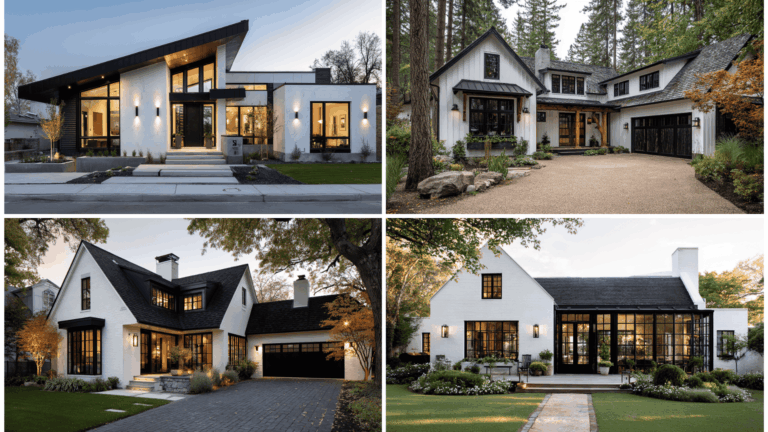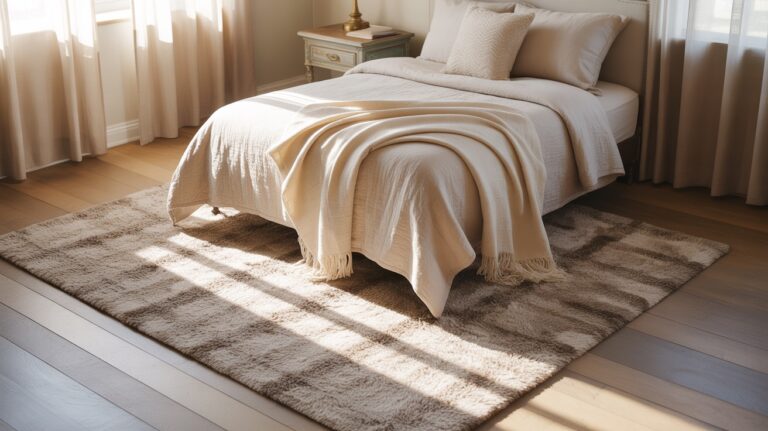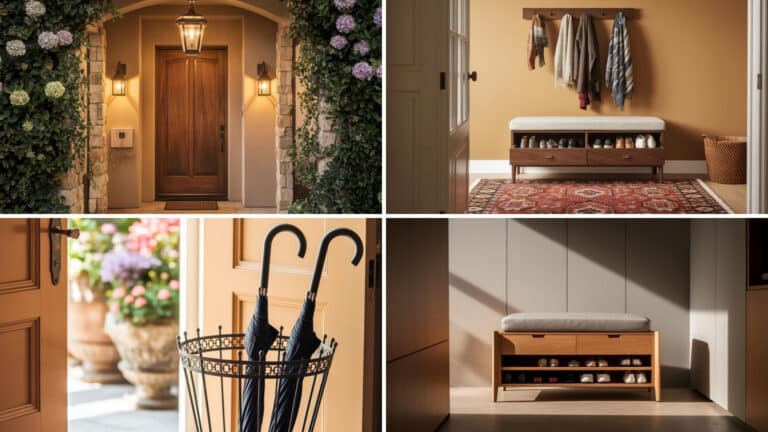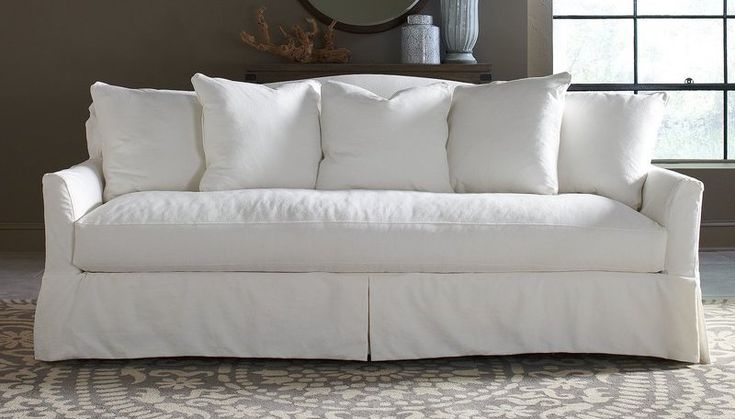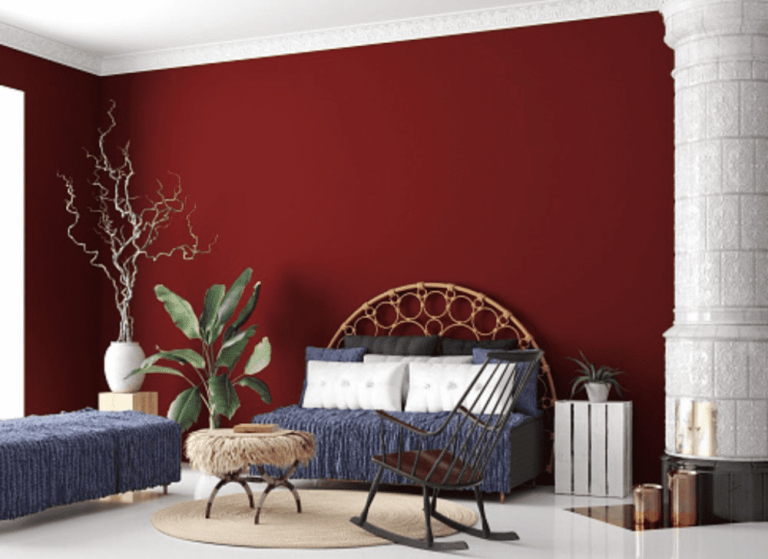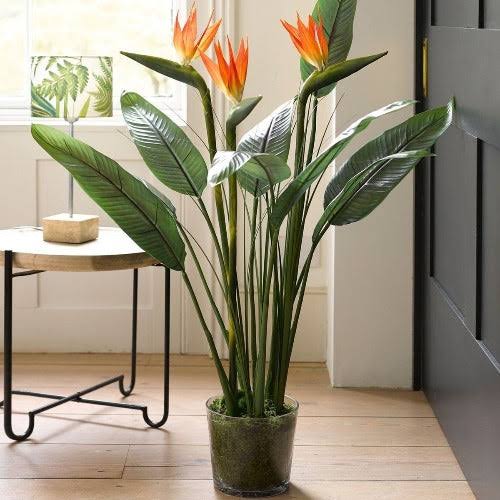35 Petal-Perfect Pot Ideas to Plant Some Joy
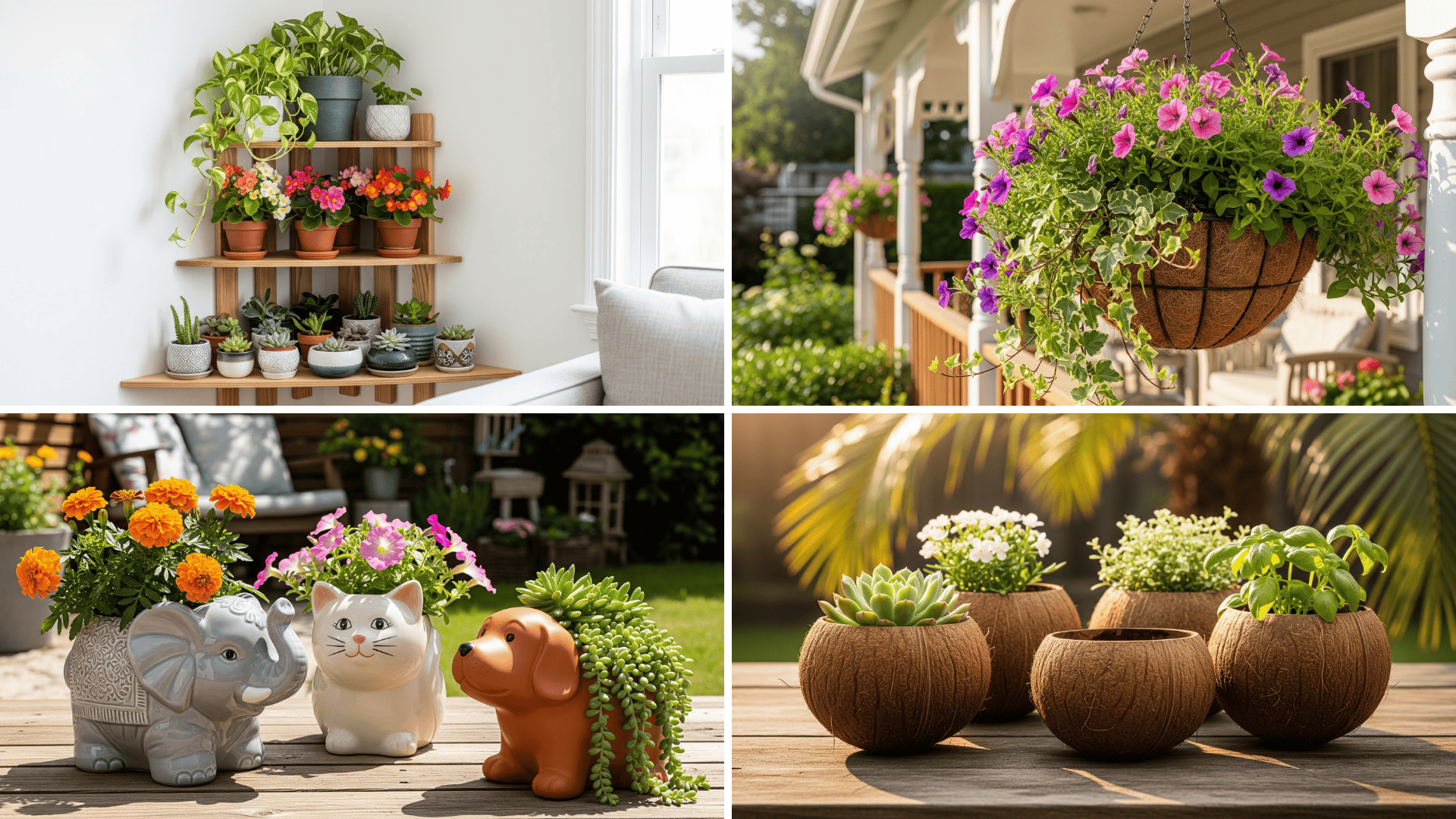
Want to add some serious charm to your outdoor and indoor spaces?
Flower pot ideas are your secret weapon for creating stunning areas that make everyone stop and stare!
The right containers can completely transform the feel of your garden, patio, or living room.
Planter ideas don’t have to be complicated or expensive; sometimes the simplest touches make the biggest impact.
Front porch planter ideas are especially fun because they’re the first thing guests see when they visit your home.
Let’s explore some creative ways to use pots and planters that will add personality, color, and life to every corner of your home and garden.
Flower Pots and Planter Ideas
Learn about these creative and unique flower pot and planter ideas to add personality, charm, and color to your garden, porch, or home:
1. Old Boots
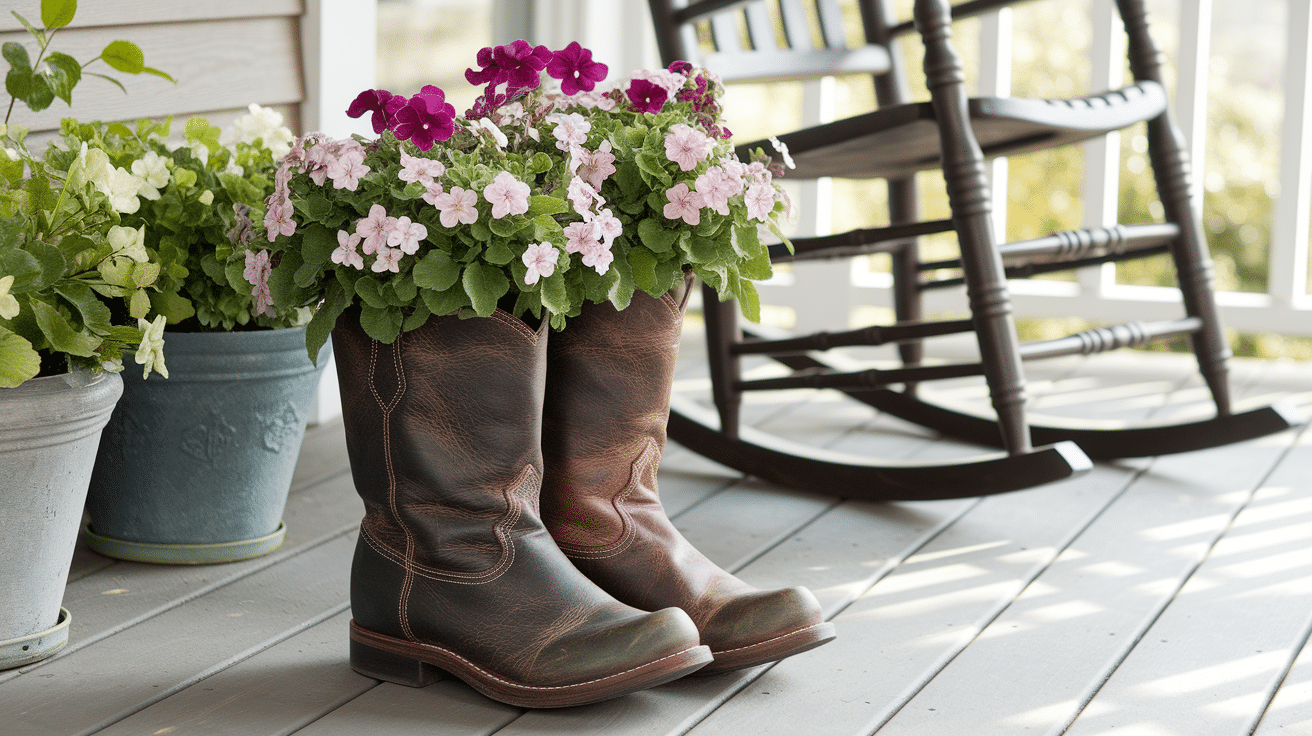
Old boots, if they are worn-out gardening shoes or well well-loved pair from the back of the closet, can be changed into rustic planters.
Their different, quirky appearance makes them best for adding personality to your outdoor or indoor space.
Simply clean the boots, drill small drainage holes in the soles to prevent waterlogging, and fill them with potting soil.
Choose hardy plants like succulents or colorful flowers that will thrive in a small, cozy environment.
Arrange them on your porch, along a pathway, or even inside as part of a whimsical display.
Pro Tip: Use colorful boots for a fun pop of color, or distress leather boots for a more vintage look.
2. Vintage Teacups and Mugs
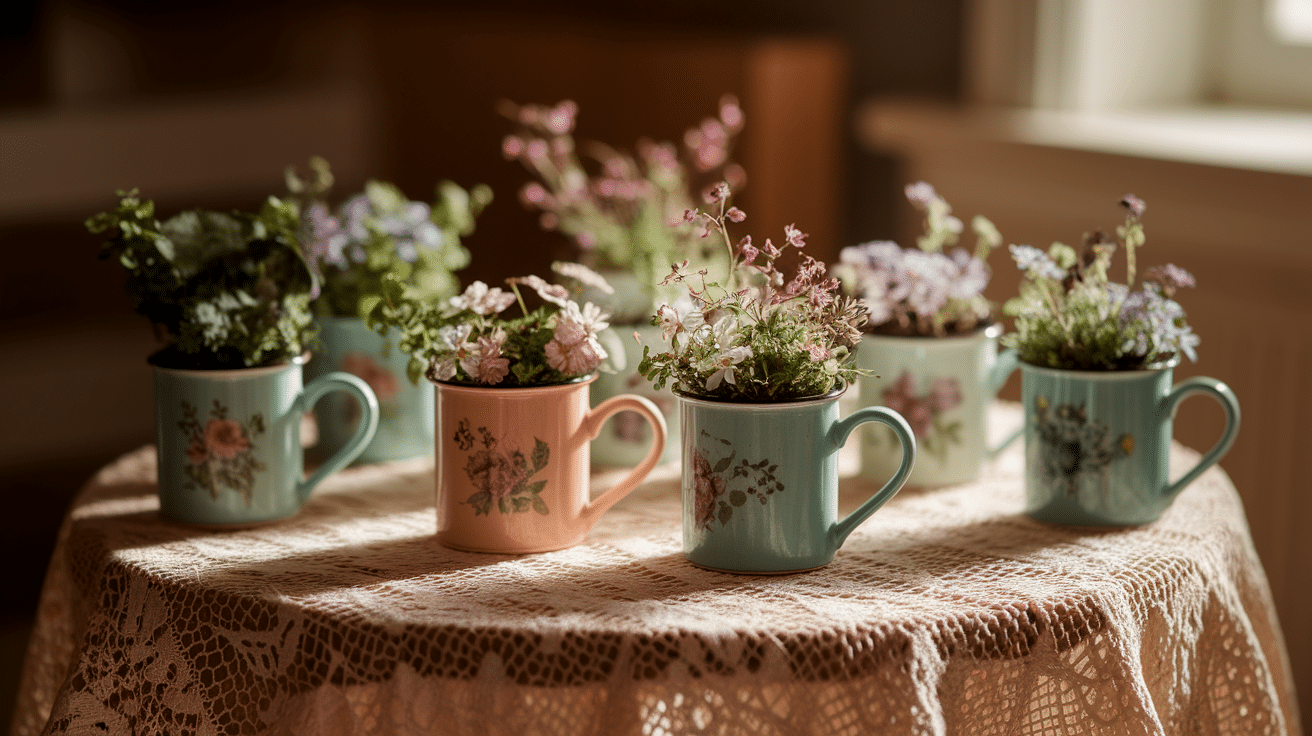
Repurposing vintage teacups and mugs as planters is an eco-friendly way to add a personal, nostalgic touch to your decor.
These small planters are best for growing small succulents, herbs, or flowers.
The whimsical nature of mismatched teacups, whether delicate floral designs or rustic, chipped mugs, brings an endearing charm to any space.
Display these on a windowsill, along your front porch, or even as part of a breakfast nook setup.
You can even paint or decorate the cups to make them match a specific theme, whether it is vintage, boho, or shabby chic.
Pro Tip: Group several teacups together for a mini garden arrangement, or use one teacup as a sweet gift for a friend with a small plant inside.
3. Tin Cans
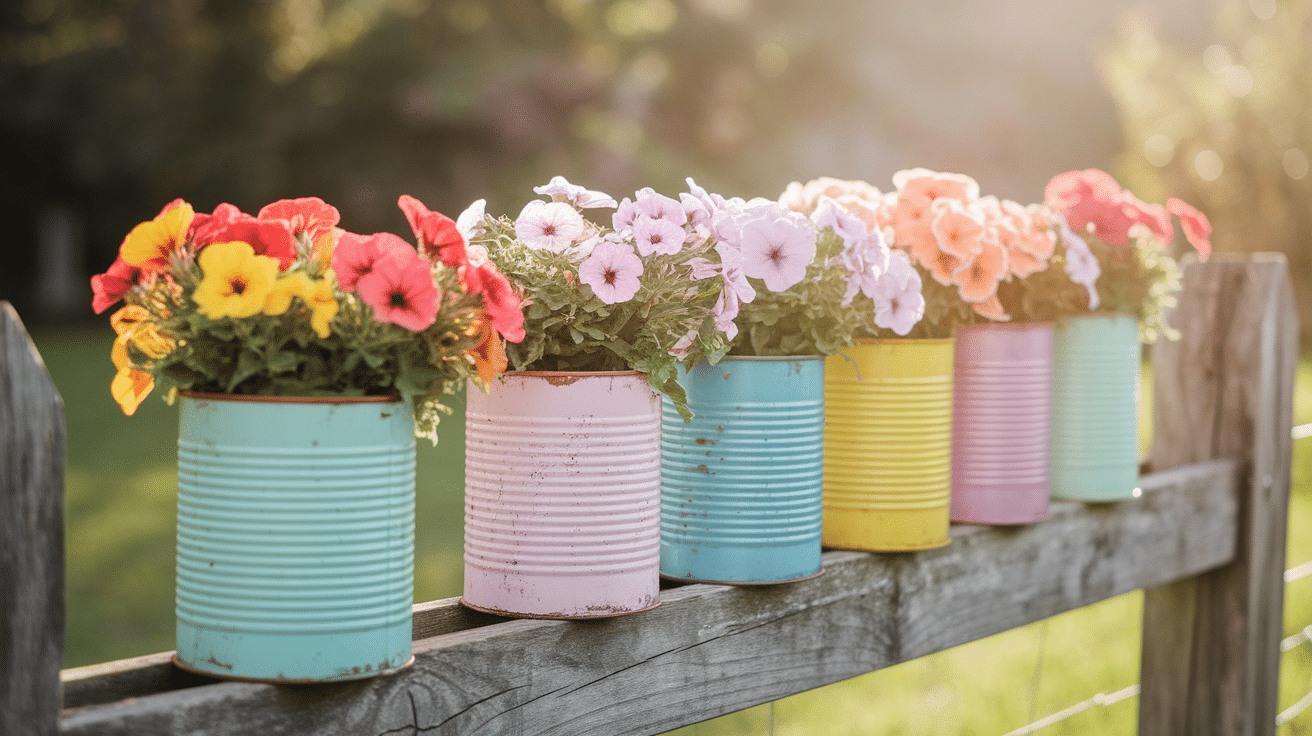
Changing old tin cans into planters is an easy and affordable way to add personality to your garden while keeping waste out of landfills.
These containers come in all shapes and sizes, making them versatile for different plant types.
You can paint or decorate tin cans with fabric, washi tape, or even chalk paint to give them a unique, customized look.
Tin cans are especially great for herbs like basil, mint, or thyme, and smaller flowers or succulents.
They work well on windowsills, railings, or along a garden fence, where they add a pop of color and texture.
Pro Tip: Use an assortment of different-sized cans for a tiered, cascading look along your porch or patio.
4. Wooden Crates
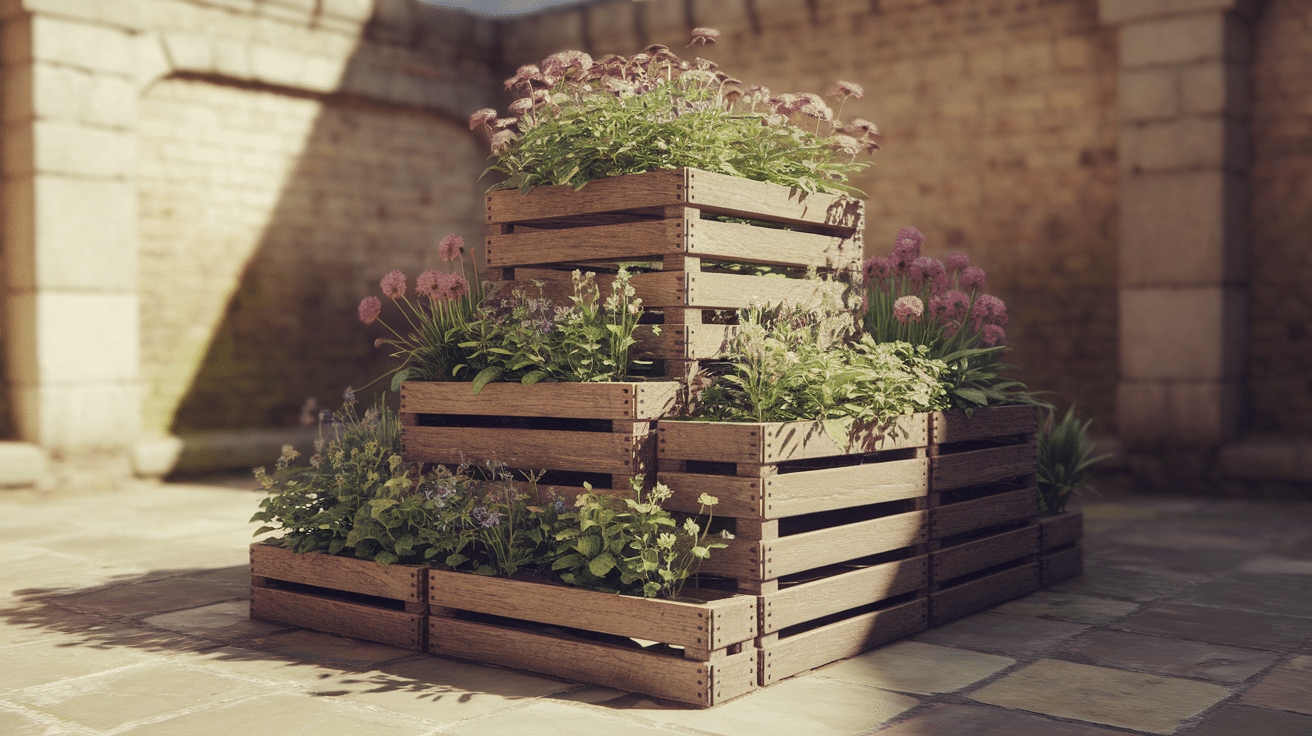
Wooden crates are an incredibly versatile and rustic planter solution.
Stack several crates to create multi-tiered planters for a vertical garden, or lay them flat to create a long, shallow bed for flowers and vegetables.
These crates can be painted or left natural, depending on the look you are going for.
For a cohesive theme, you can even stencil designs or messages on the sides of the crates to add a personal touch.
Wooden crates are best for plants that need a bit more space to grow, like lavender, herbs, or climbing flowers.
Pro Tip: Use wooden crates as a base for cascading plants, such as ivy or morning glories, for a charming vertical garden display.
5. Wine Barrels
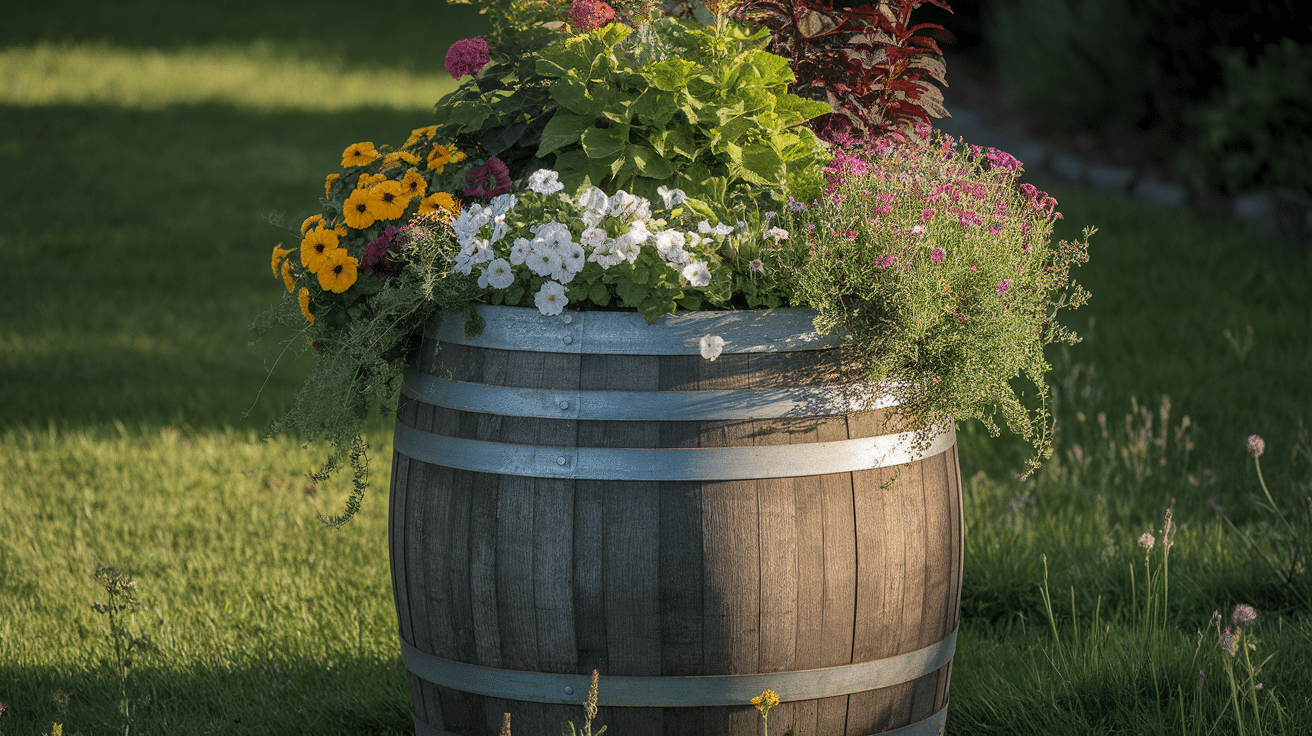
Wine barrels are large, rustic containers that offer a lot of planting space and can serve as an eye-catching feature in your garden or porch.
These barrels are typically made of oak, which gives them a natural finish that blends well with any outdoor setting.
The size of a wine barrel makes it best suited for statement plants, such as shrubs, small trees, or larger flowering plants like hydrangeas, roses, or sunflowers.
Because of their large size, wine barrels are flawless for creating focal points in your outdoor space, whether you want to line your front porch or set them at the entrance to your garden.
You can even create a mini garden by filling the barrel with layers of plants, mixing colors, textures, and heights to create a dynamic look.
Pro Tip: Drill drainage holes at the bottom of the barrel and use a liner to retain soil. You can even add a little compost or organic material to improve the quality of the soil inside.
6. Hanging Baskets
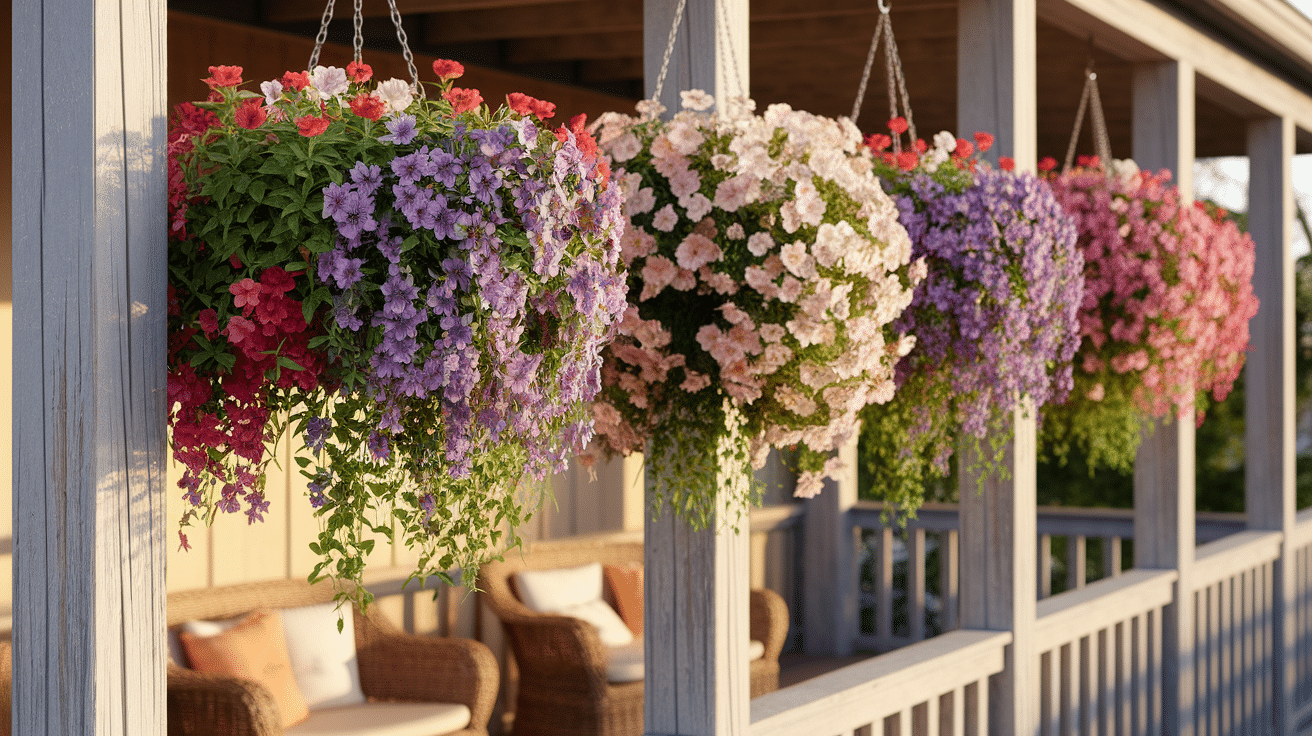
Hanging baskets are a classic way to introduce cascading plants into your garden or home.
These planters hang from ceilings, hooks, or brackets, allowing trailing plants such as ivy, petunias, or ferns to spill over the sides and create an attractive cascading effect.
To create a lush, full look, choose plants with long vines or flowers that thrive in the conditions of your space.
Make sure the baskets have proper drainage holes to prevent water buildup, and consider using coco liners or sphagnum moss for a natural, textured look.
Pro Tip: Choose colorful flowers or trailing plants like begonias or impatiens to brighten up your space. You can also mix and match plants with varying textures for a more dynamic effect.
7. Wall-Mounted Planters
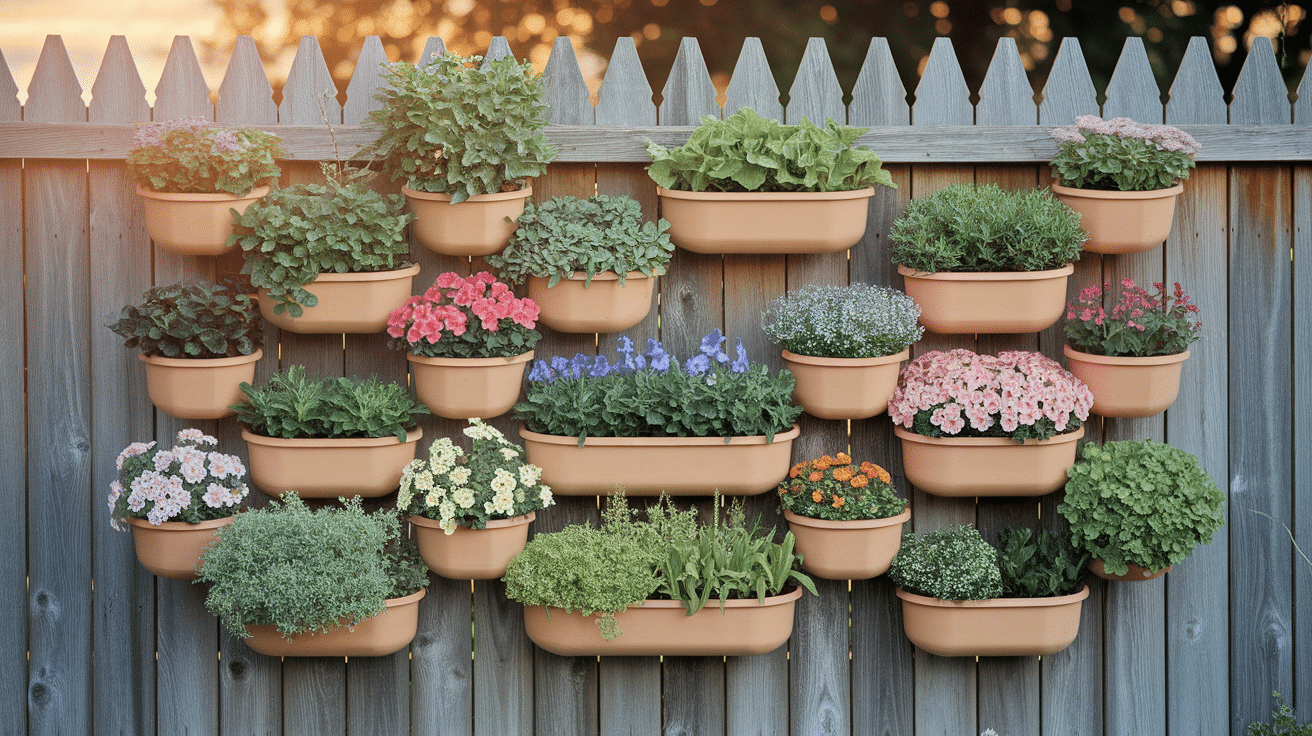
Wall-mounted planters offer a great way to maximize space in small or urban gardens.
By attaching planters to fences, garden walls, or trellises, you can create a green wall effect, making use of vertical space.
Wall-mounted planters can come in a variety of materials, including ceramic, metal, or wood, allowing them to blend smoothly with different homes.
These planters are suited best for growing everything from climbing vines like morning glories to herbs such as rosemary and thyme.
To make the most of this option, group several planters together for a bold visual impact, or stagger them at different heights for an interesting layout.
Pro Tip: Use wall-mounted planters to grow climbing plants or even vegetables. Consider adding a trellis behind the planters to support the growth of plants like peas or cucumbers.
8. Macramé Plant Hangers
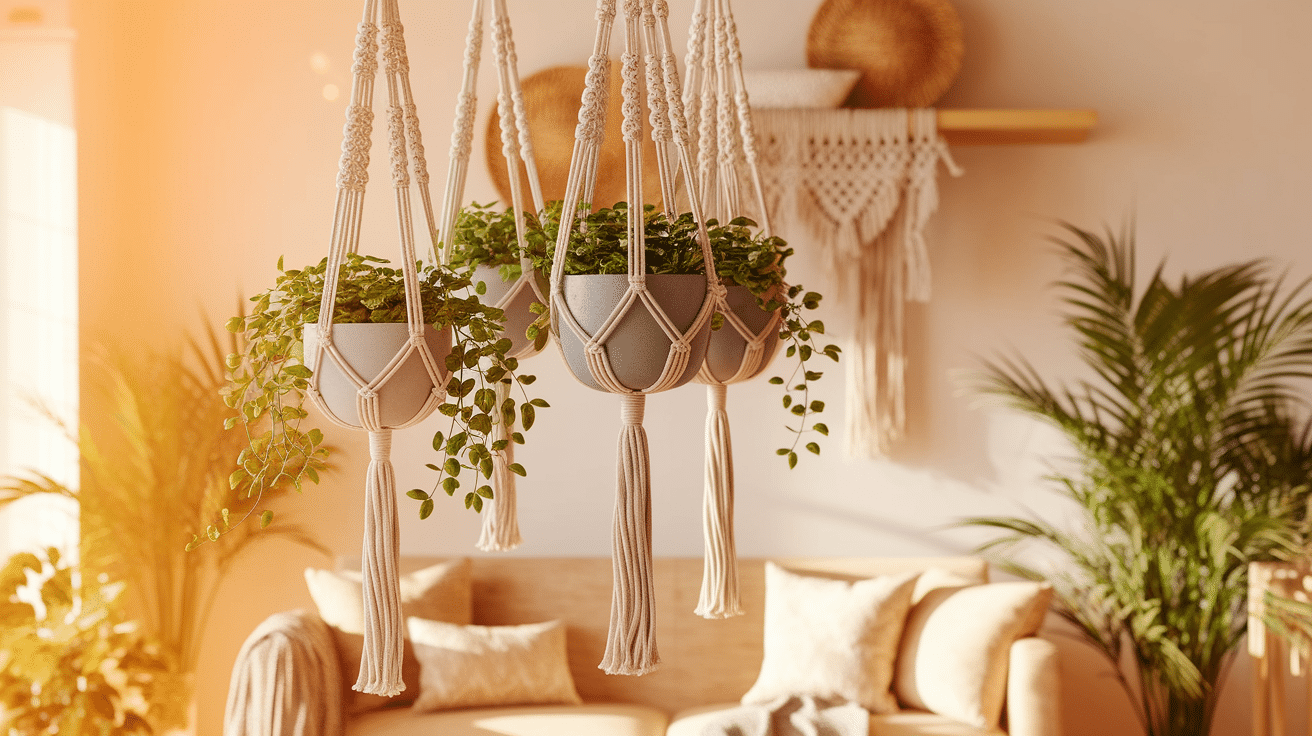
Macramé plant hangers are an easy way to add texture and a boho-chic vibe to your space.
These handmade hangers, crafted from cotton or jute, offer a stylish and eco-friendly way to suspend plants from the ceiling or wall.
These hangers can be incorporated into any room of your home if you hang them from a corner of the living room, near windows for plants to get plenty of light, or outside on your patio.
Their woven, knotty design adds depth and a touch of vintage charm to your greenery, making them good for a laid-back, relaxed atmosphere.
Pro Tip: Combine different lengths of macramé hangers to create a layered look, and choose plants with trailing foliage to improve the boho appeal.
9. Vertical Ladder Planters
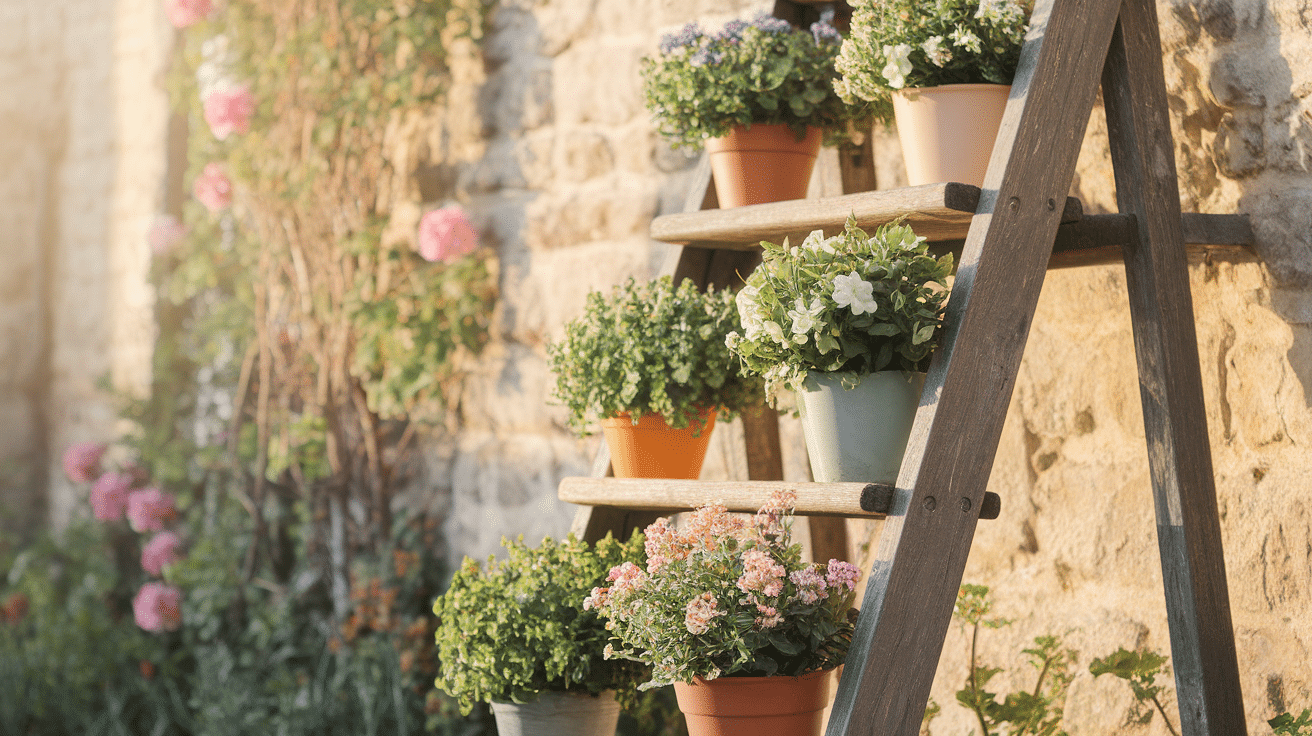
Vertical ladder planters are the best way to maximize space while maintaining an organized and decorative approach.
This design uses a tiered ladder structure, with each step or shelf acting as a platform for a flower pot or planter.
They can be made from wood, metal, or even repurposed furniture pieces.
These planters are not just decorative but also practical, as the different levels make it easy to place plants that need varying amounts of sunlight.
Pro Tip: Opt for a combination of flowers, herbs, and small vegetables for a tiered garden display. Ladder planters also work well in narrow spaces such as apartment balconies or compact patios.
10. Repurposed Shoe Organizer Planter
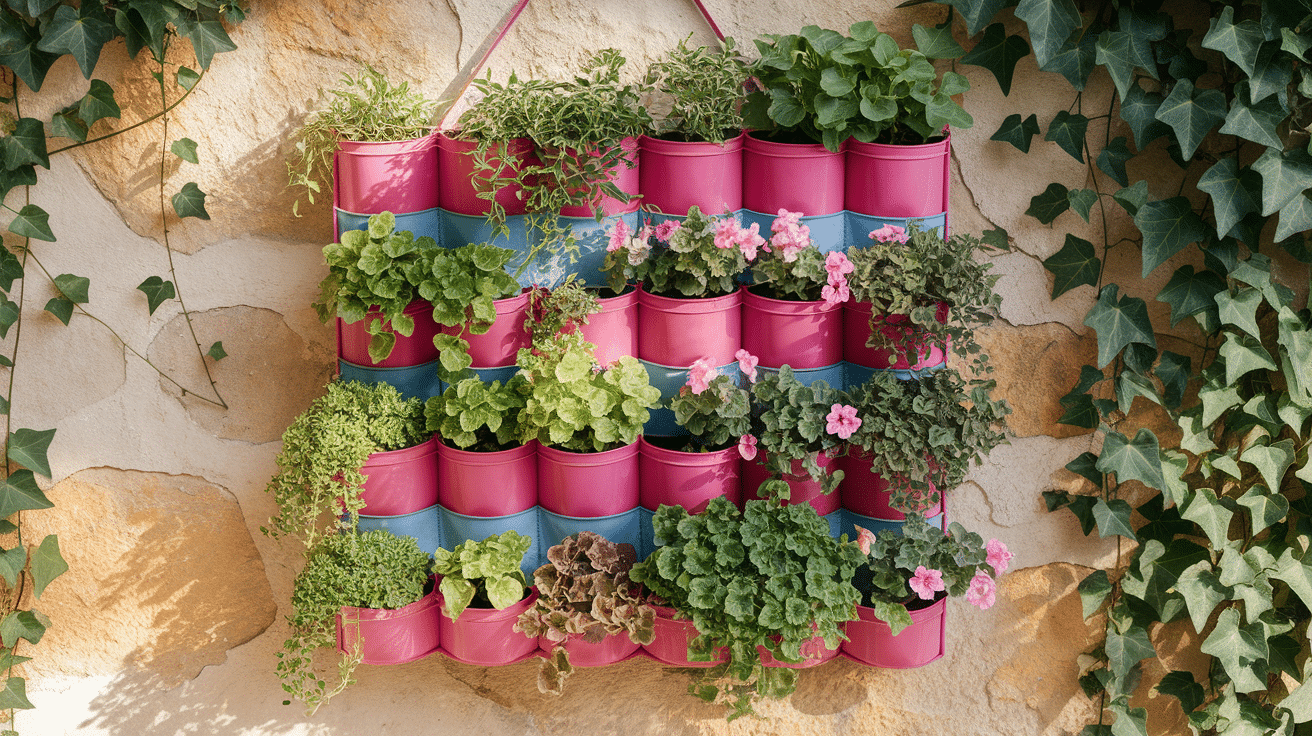
A shoe organizer can be repurposed into a space-efficient planter that is best for growing smaller plants or herbs.
This is especially useful for gardeners who do not have much space or those who want to grow plants in a compact, vertical layout.
Hanging the shoe organizer on a fence, wall, or even a balcony railing allows you to grow plants in pockets, saving space while adding a creative touch to your garden or home.
These organizers can also be used to store plant tools, seeds, or small gardening supplies, making them a functional and practical solution.
Pro Tip: Choose plants that do not need deep soil for this type of setup, such as strawberries, lettuce, or small herbs like mint and basil.
11. Animal-Shaped Planters
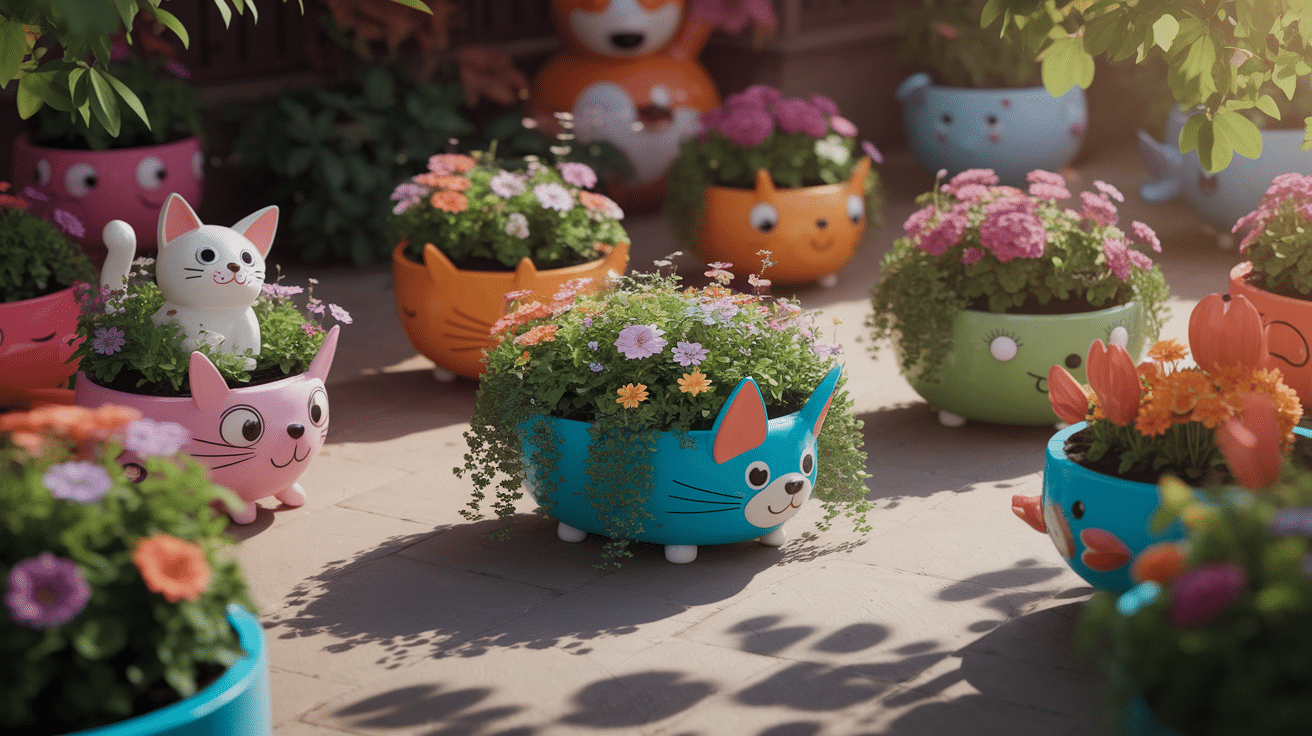
Animal-shaped planters are a playful way to add character to your garden or indoor space.
These planters are designed to look like various animals, such as cats, dogs, elephants, or even mythical creatures like unicorns.
They are best for creating a fun and lively atmosphere, especially in children’s gardens, patios, or anywhere you want to add a touch of whimsy.
These planters come in different materials, from ceramic to resin, and are often designed with intricate details to bring the animals to life.
You can plant anything from small flowers to succulents or even herbs in these cute animal containers.
Pro Tip: Choose an animal planter that complements the type of plant you are growing.
12. Face Planters
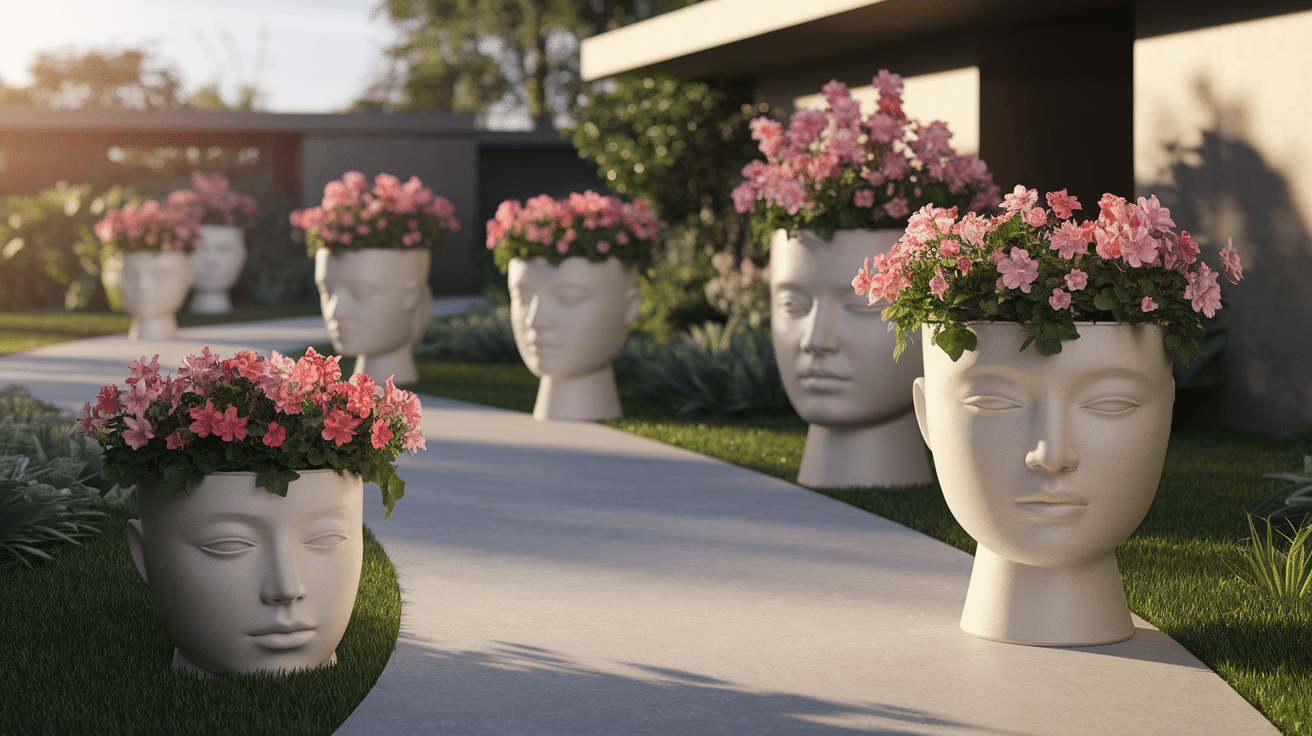
Face planters are a wonderful way to add personality and artistic flair to your garden or living room.
These planters feature human faces, abstract faces, or even whimsical caricatures, making them more than just vessels for plants; they become statement pieces.
From ancient Greek-style faces to modern, minimalistic designs, face planters can range from simple to bold, matching any décor style.
Place these planters strategically around your garden or home, allowing the plant to grow from the head or mouth of the face for an almost surreal visual effect.
Pro Tip: Mix and match different face planters with varying expressions and colors for a fun, eclectic display.
13. Whimsical Figurines
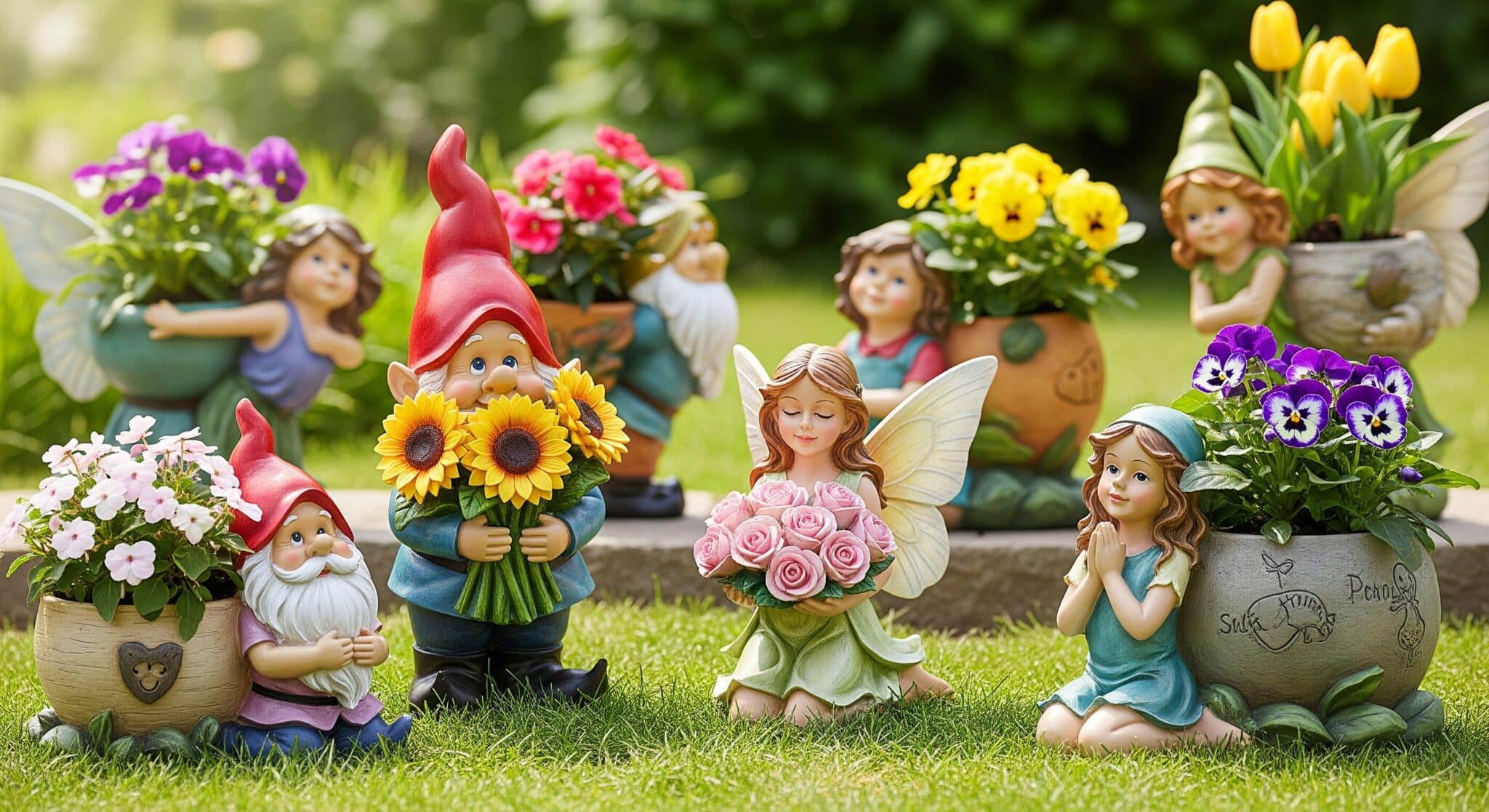
Whimsical figurines serve as both decorative and functional elements in your garden.
Whether they are fairy garden statues, gnome figurines, or abstract sculptures, these planters acts as a works of art.
These planters can be a good addition to a fairy garden, a child’s outdoor space, or even as quirky decor in your indoor plant displays.
Many figurines feature hollow areas where plants can be placed, allowing for both the artwork and greenery to coexist harmoniously.
Pro Tip: Pair whimsical figurine planters with small, colorful plants like pansies or marigolds for a vibrant, magical effect.
14. Colorful Painted Pots
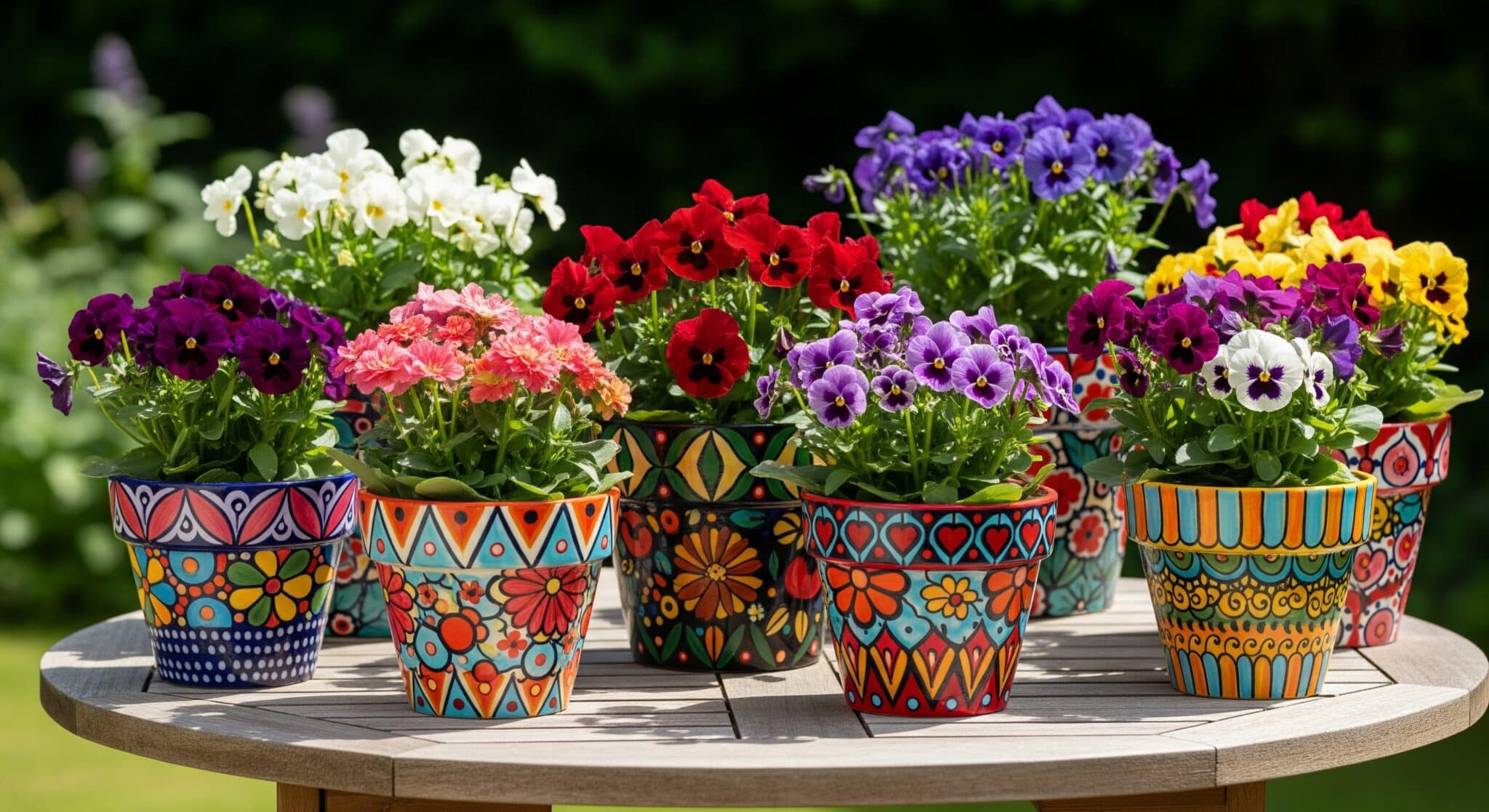
Colorful painted pots are one of the easiest and most creative ways to add vibrancy to your garden or home.
You can paint your own pots with bold patterns, bright colors, or even intricate designs to suit your personal style or the theme of your space.
If you do not want to paint the entire pot, you can also use colorful tapes, stencils, or even decoupage techniques to add patterns or images.
Painted pots are best for adding personality to porches, patios, or window sills.
Pro Tip: Choose colors that complement the plants you plan to place in the pots.
15. Concrete Planters
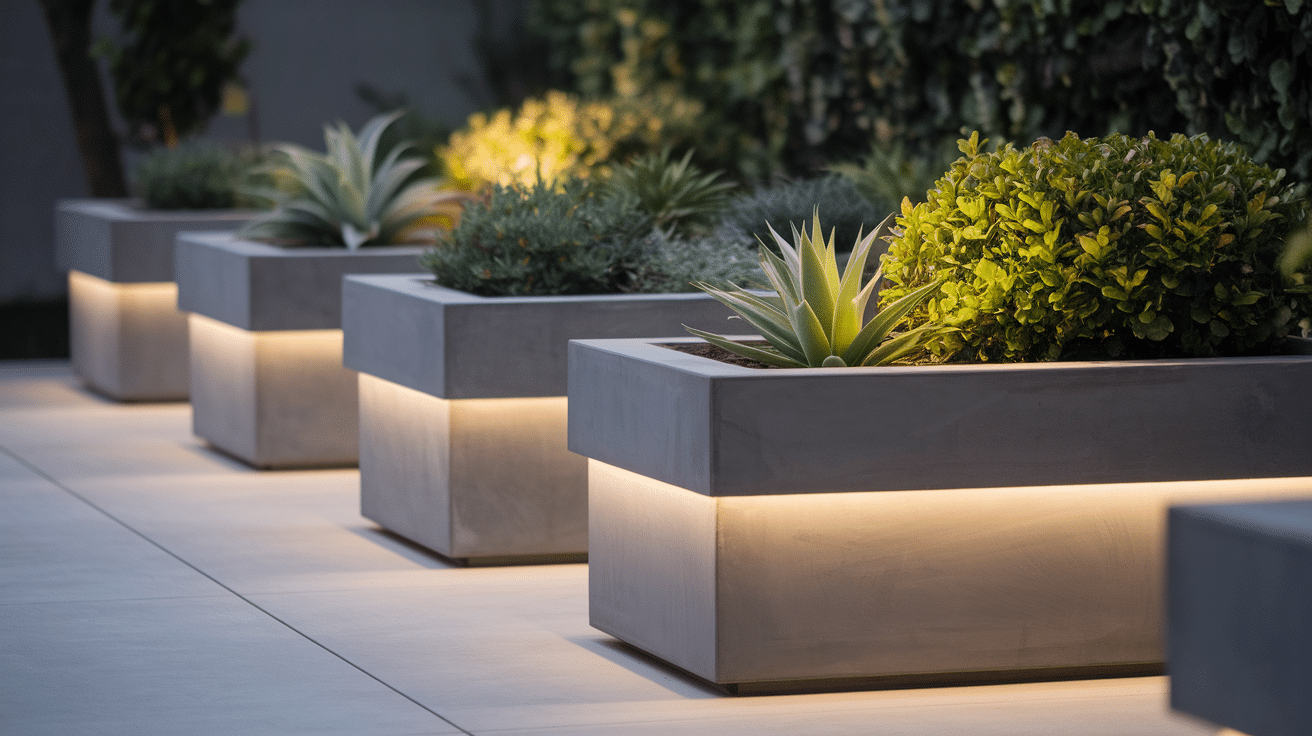
Concrete planters have become synonymous with modern, industrial decor.
These planters have a raw, minimalist appeal that complements clean, neutral spaces.
Their matte, smooth finish gives them a sleek look that works well in both indoor and outdoor environments.
Whether in a small apartment or a spacious outdoor garden, concrete planters create a bold, structured vibe.
Pro Tip: Concrete planters are best suited for succulents, cacti, and other low-maintenance plants that need a bit of extra weight and support.
16. Geometric Ceramic Pots
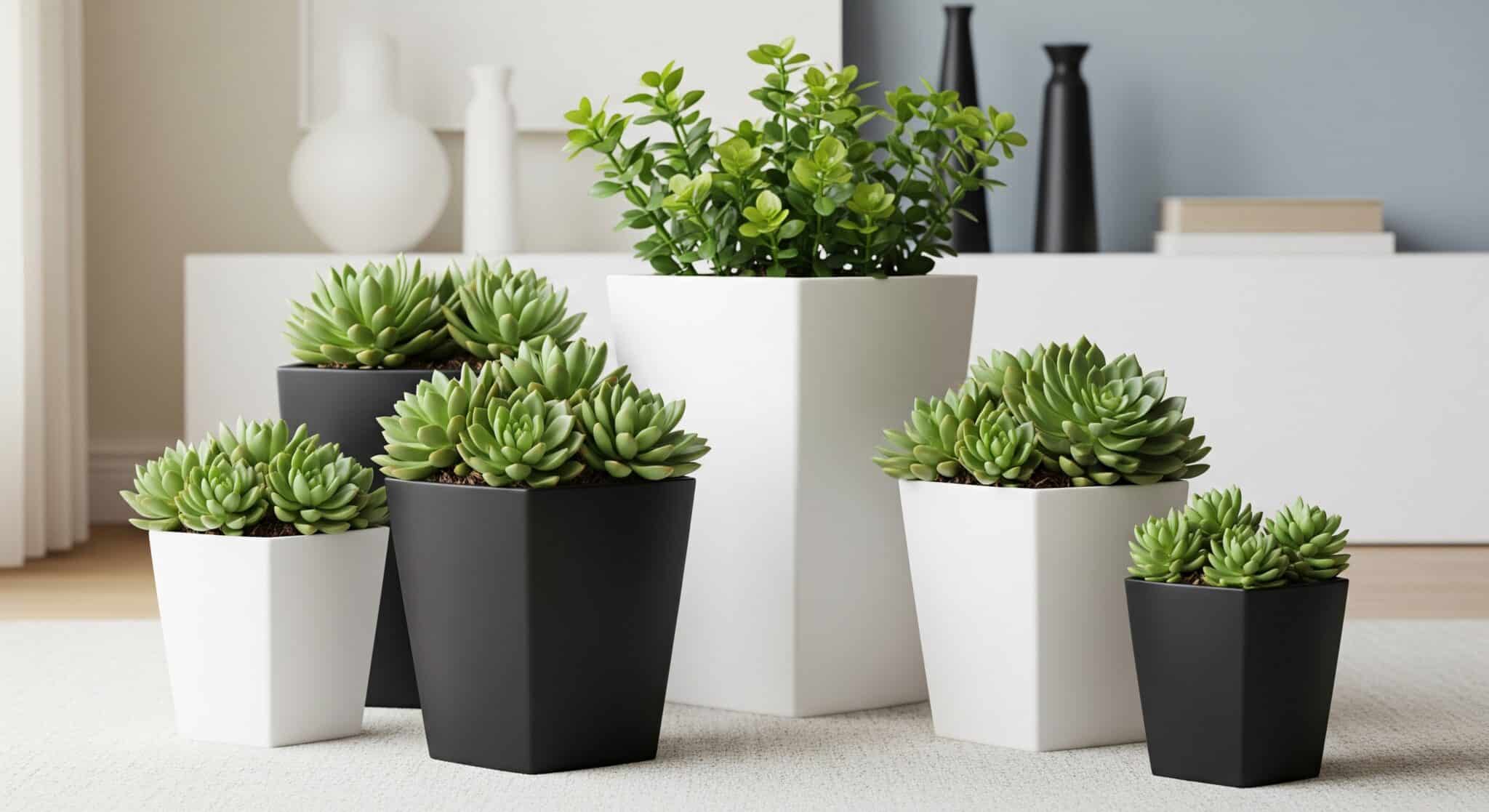
Geometric ceramic pots bring sharp, angular designs to the forefront of modern garden visual appeals.
These planters often feature hexagonal, triangular, or cubical shapes, offering a sleek and bold contrast to the soft curves of plants.
The smooth, glossy ceramic finish improves their sophisticated appearance, and they often come in neutral tones like white, gray, or matte black.
These planters are best suited for showcasing plants with clean lines, such as succulents, ferns, or small indoor plants.
Pro Tip: Pair these geometric pots with modern furniture or décor elements, such as metal shelving or industrial lighting, to create a cohesive modern style.
17. Concrete and Wood Combo Planters
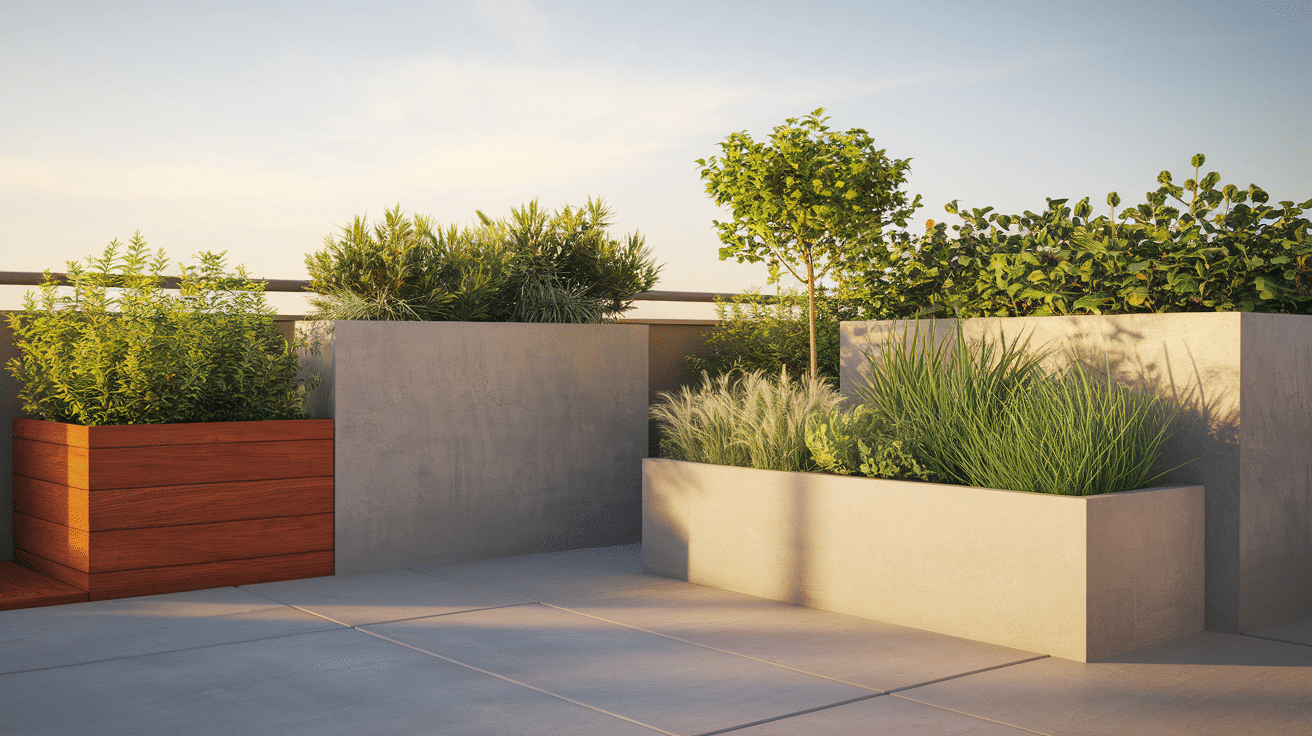
Combining industrial concrete with the warmth of natural wood creates a striking contrast in modern planters.
Concrete and wood combo planters offer a balance of harsh and soft materials, which can complement contemporary interior designs.
These planters can be square or rectangular, providing ample space for larger plants.
They look especially great in spaces where raw materials are embraced, such as loft apartments or urban gardens.
Pro Tip: Pair these combo planters with plants like snake plants, monstera, or fiddle leaf figs to highlight the contrast between the natural wood and structured concrete.
18. Ceramic Planters with Clean Lines
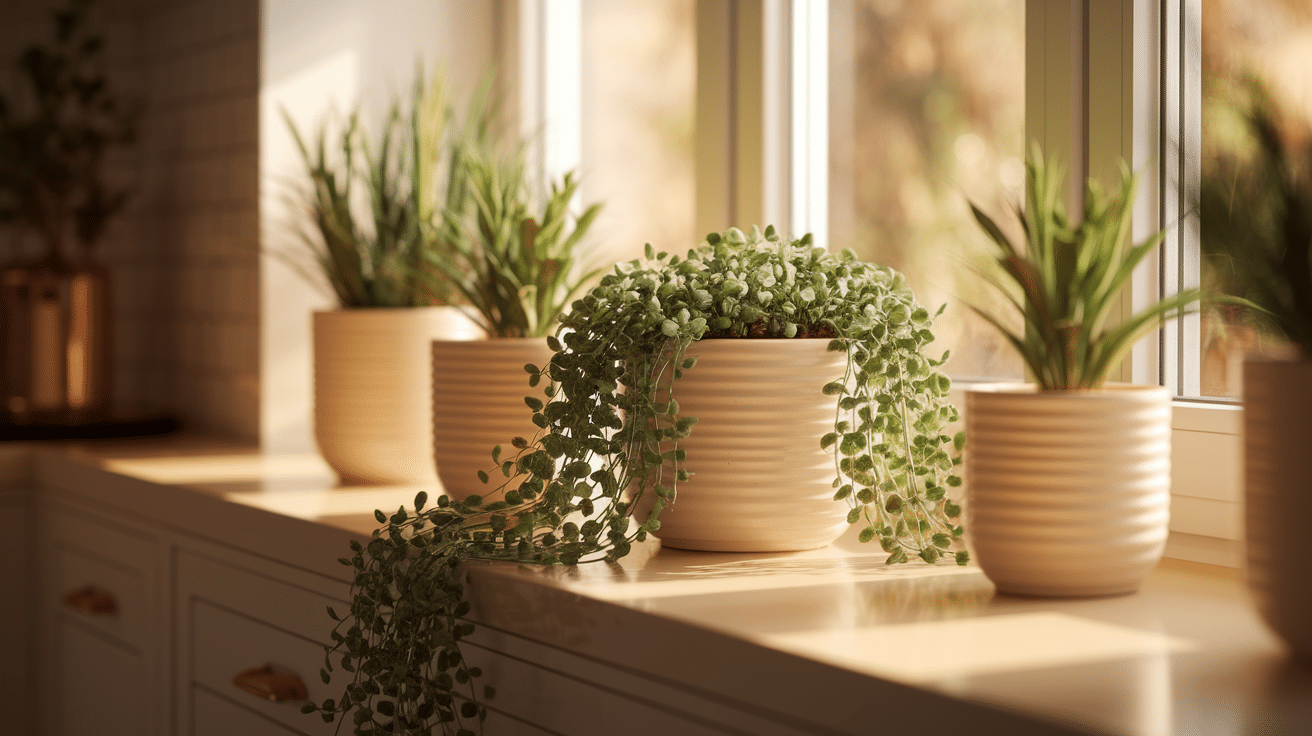
Ceramic planters with clean lines are the epitome of modern minimalism.
These planters often feature smooth, uniform surfaces with a focus on simplicity.
Available in neutral shades like beige, white, or muted gray, ceramic planters with clean lines offer a subtle yet sophisticated look.
These planters often have a neutral finish, which highlights the plants themselves, making them the star of the show.
Pro Tip: Choose minimalist plants like succulents, orchids, or small palm varieties that complement the subtle elegance of the ceramic pot.
19. Hollowed Logs
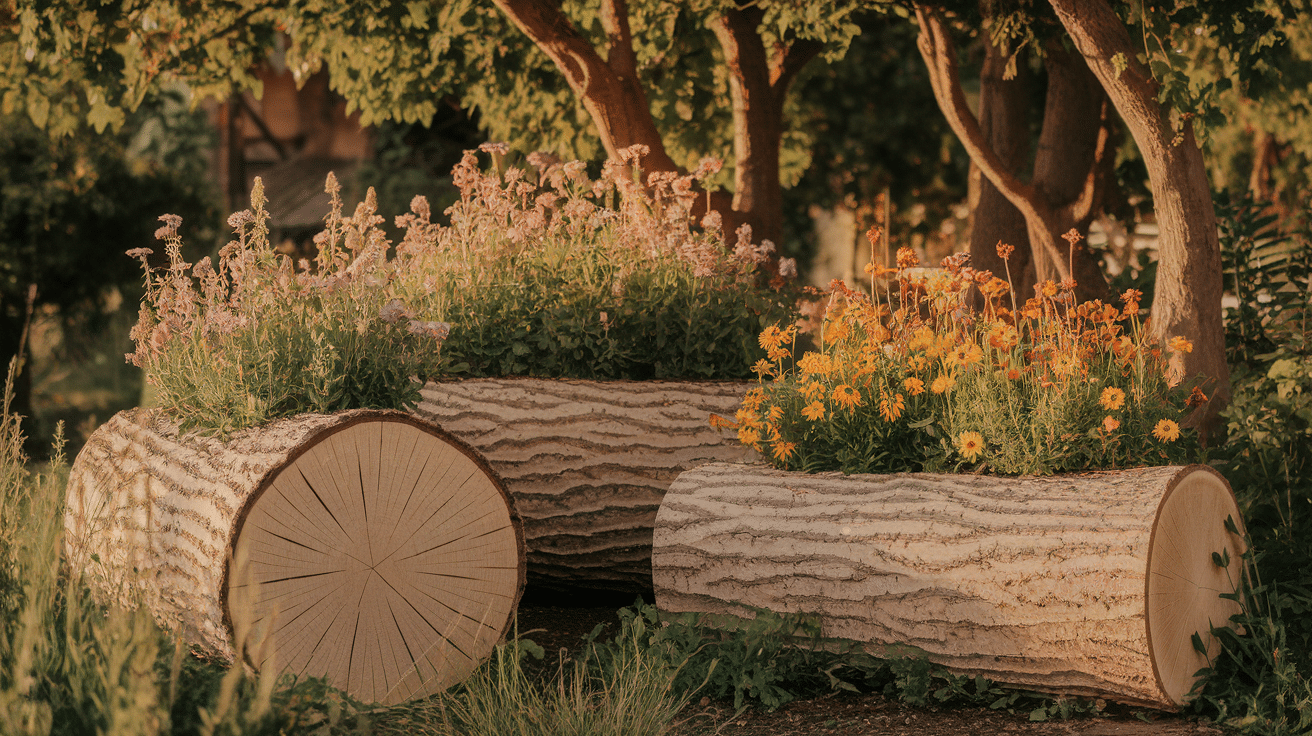
Hollowed logs offer a natural way to bring a rustic touch to your garden.
Logs are often upcycled from fallen trees or branches, making them an eco-friendly option for planters.
When the inside of the log is hollowed out, it serves as a good container for plants to thrive in.
These planters are good for larger plants like ferns, wildflowers, or shrubs, as they offer ample space for roots to grow.
Pro Tip: Ensure that the log is properly treated to prevent rot, especially if it is placed outdoors.
20. Stone Planters
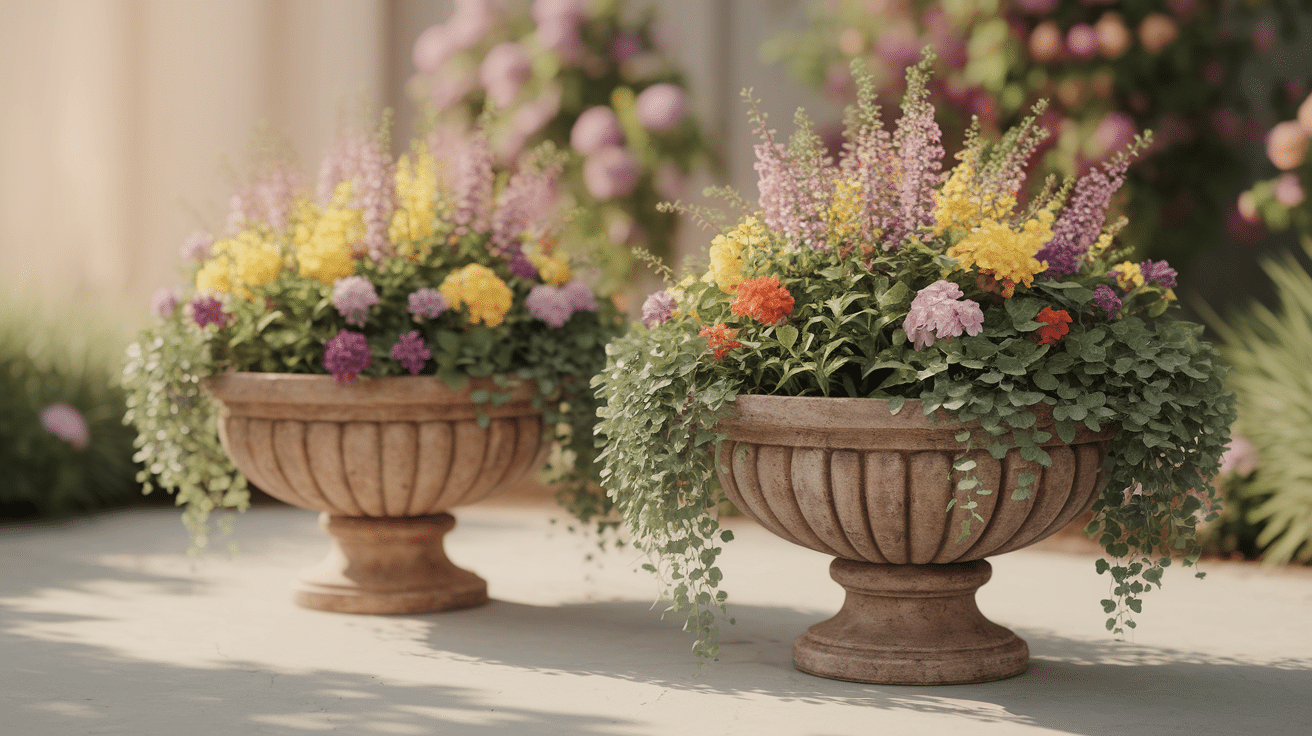
Stone planters offer a lasting, rustic look that fits well in outdoor spaces.
Made from natural stones like granite, slate, or sandstone, these planters can range from simple rock containers to intricately carved works of art.
Their heavy, sturdy construction ensures that they can support large plants, including trees, shrubs, or perennial flowers.
Whether placed as a single statement piece or in a series along a walkway, stone planters bring a sense of permanence and strength to any outdoor space.
Pro Tip: Stone planters can be a bit heavy, so be sure to place them in a location where they won’t need to be moved often.
21. Clay and Terracotta Pots
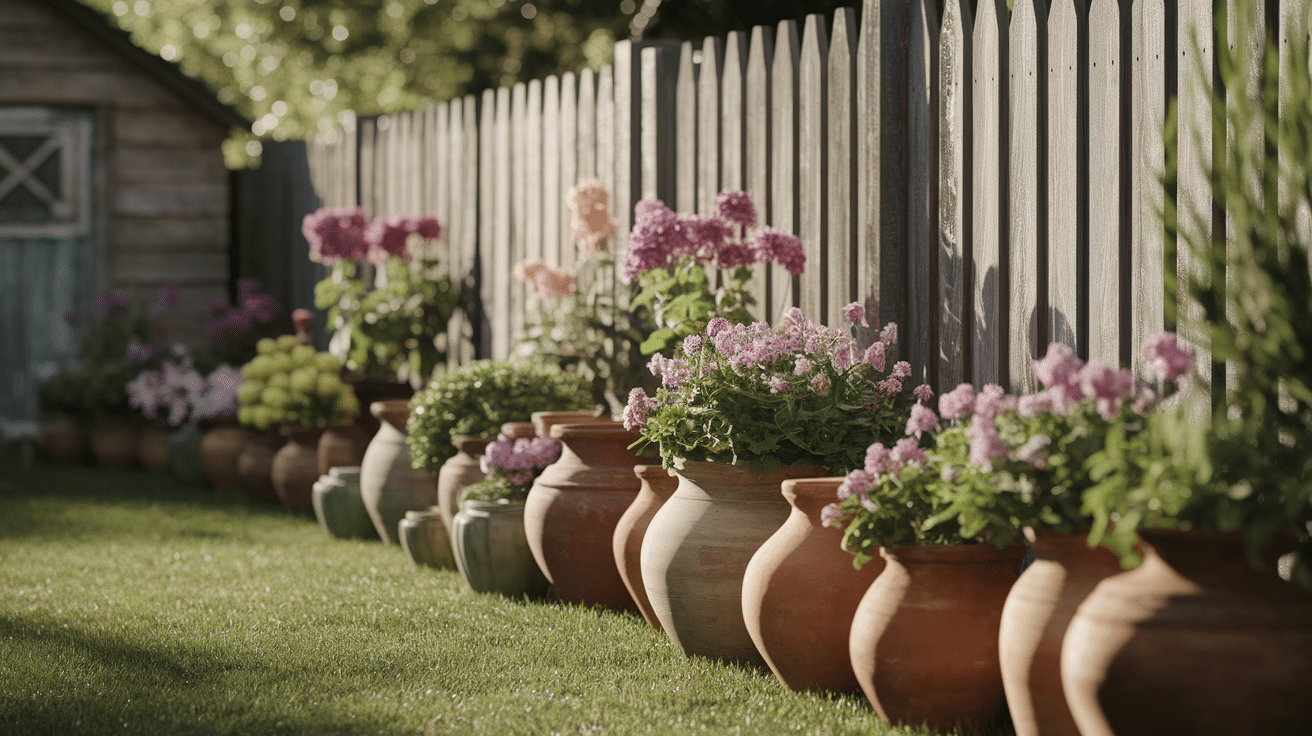
Clay and terracotta pots are classic garden planters that never go out of style.
These pots are made from fired clay, giving them a warm, earthy color that complements a wide range of plants.
Their porous nature helps with drainage, making them a good choice for plants that prefer well-drained soil, such as succulents, herbs, and Mediterranean plants.
Whether used in a rustic garden or as part of a more modern design, clay and terracotta pots offer versatile, timeless beauty.
Pro Tip: Clay and terracotta pots can dry out faster than other materials, so make sure to water plants regularly, especially during hot months.
22. Coconut Shell Planters
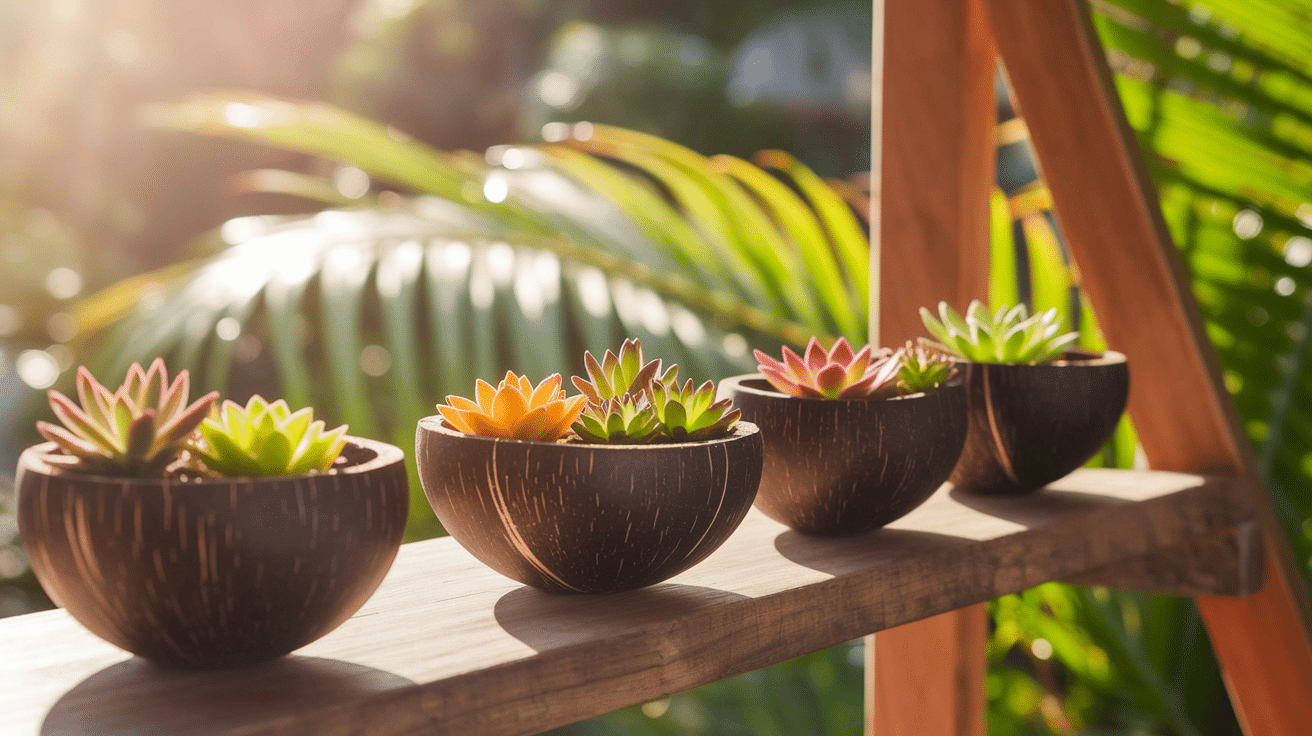
Coconut shell planters are an eco-friendly and natural alternative to plastic containers.
These planters are made from the husks of coconuts and are typically hollowed out to create small, rounded containers.
Their rustic texture and natural fibers give them a different, earthy appeal.
The coconut husk naturally helps with drainage, making it best for plants that need to dry out between waterings.
Pro Tip: To improve the durability of coconut shell planters, consider lining the inside with a small sheet of mesh or burlap before adding soil.
23. Bamboo Planters
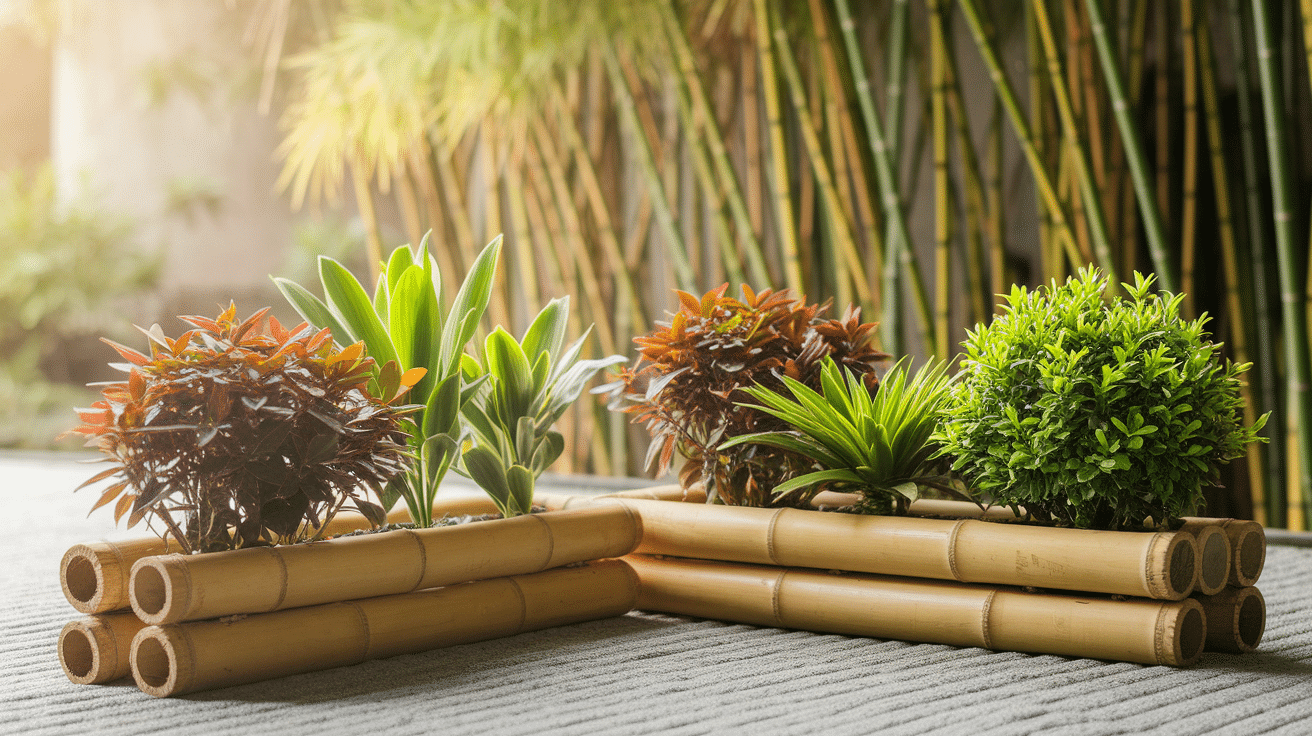
Bamboo planters offer a fresh, eco-friendly approach to garden containers.
Bamboo is a fast-growing, sustainable material, making these planters an environmentally responsible choice.
Bamboo planters can come in various forms, from simple bamboo tubes to woven baskets or even bamboo troughs.
The natural look of bamboo fits well in both modern and rustic settings, adding a touch of nature and tranquility to your garden.
Pro Tip: Bamboo planters can be a little more fragile than other materials, so it is best to avoid placing them in areas with extreme weather conditions.
24. Wheelbarrow Planters
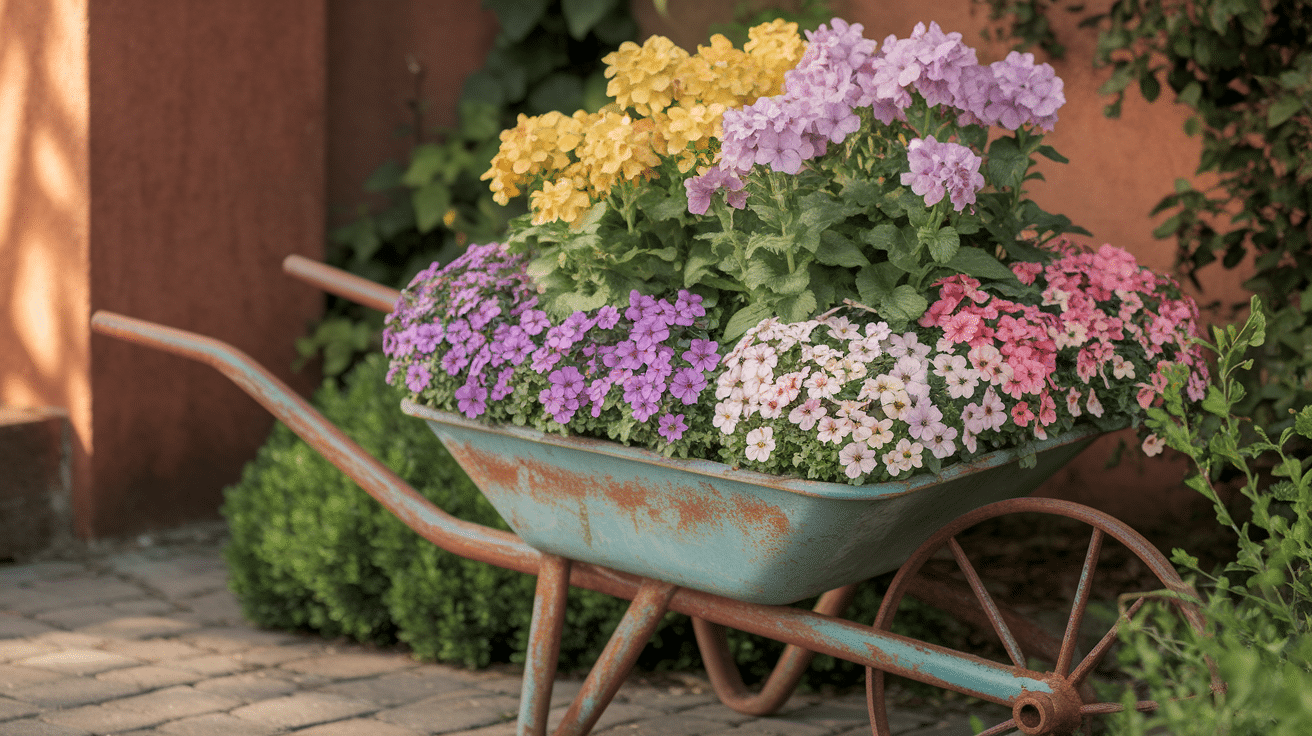
Wheelbarrow planters give a vintage and rustic look to any garden.
They work as useful garden containers and also bring a classic feel to your outdoor area.
If you have an old wheelbarrow or use a vintage-style one, you can fill it with flowers, herbs, or small shrubs to make it stand out in your garden.
Place them on patios, balconies, or in garden corners to add a special feature with a rustic touch.
Pro Tip: Use wheelbarrow planters for colorful flowers, cascading plants, or trailing vines to create a lively and dynamic look.
25. Planter Boxes with Trellises
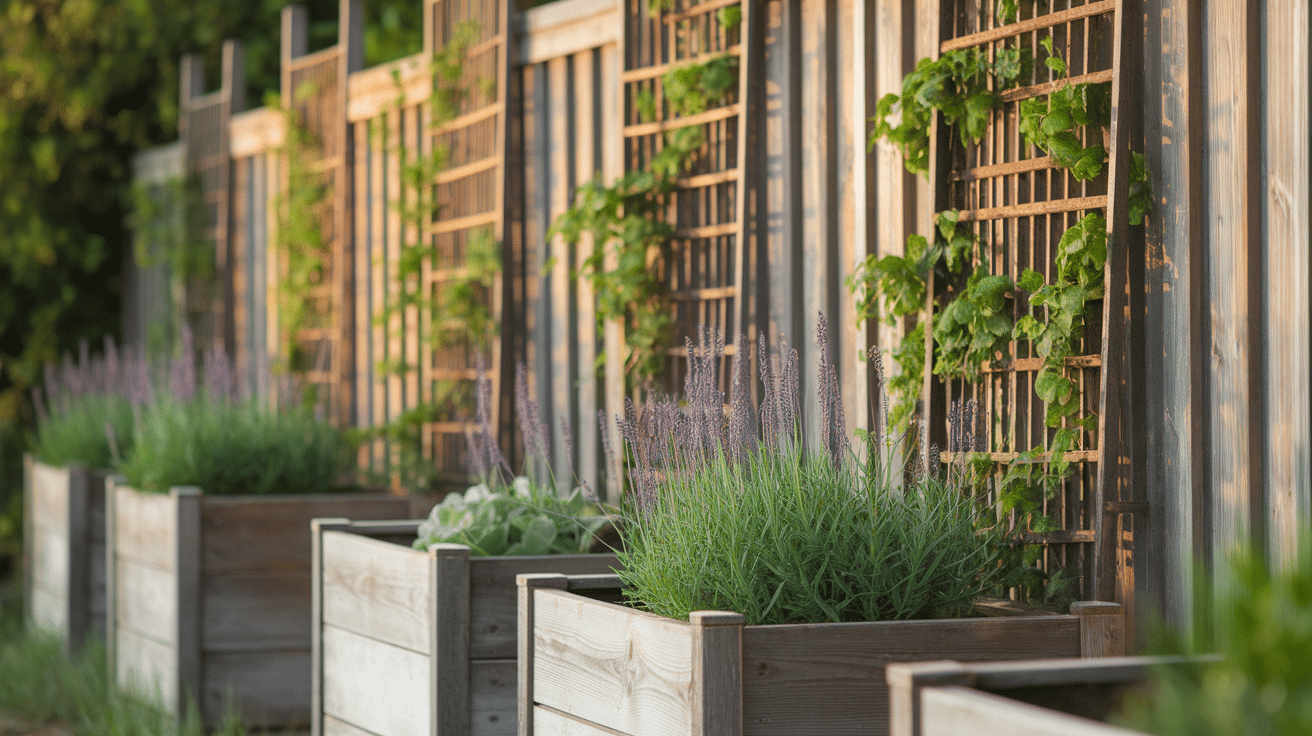
Planter boxes with trellises are good for growing climbing plants, vines, and even some vegetables that need support as they grow.
This vertical gardening option helps to reduce clutter and allows plants to spread out without taking up too much ground space.
Planter boxes with trellises fit well in small gardens, balconies, or patios where space is limited.
They can be used to create privacy screens, add green accents to walls, or support climbing flowers like morning glories or sweet peas.
Pro Tip: Choose planter boxes with sturdy trellises that can support heavy vines or fruiting plants.
26. Holiday-Themed Planters
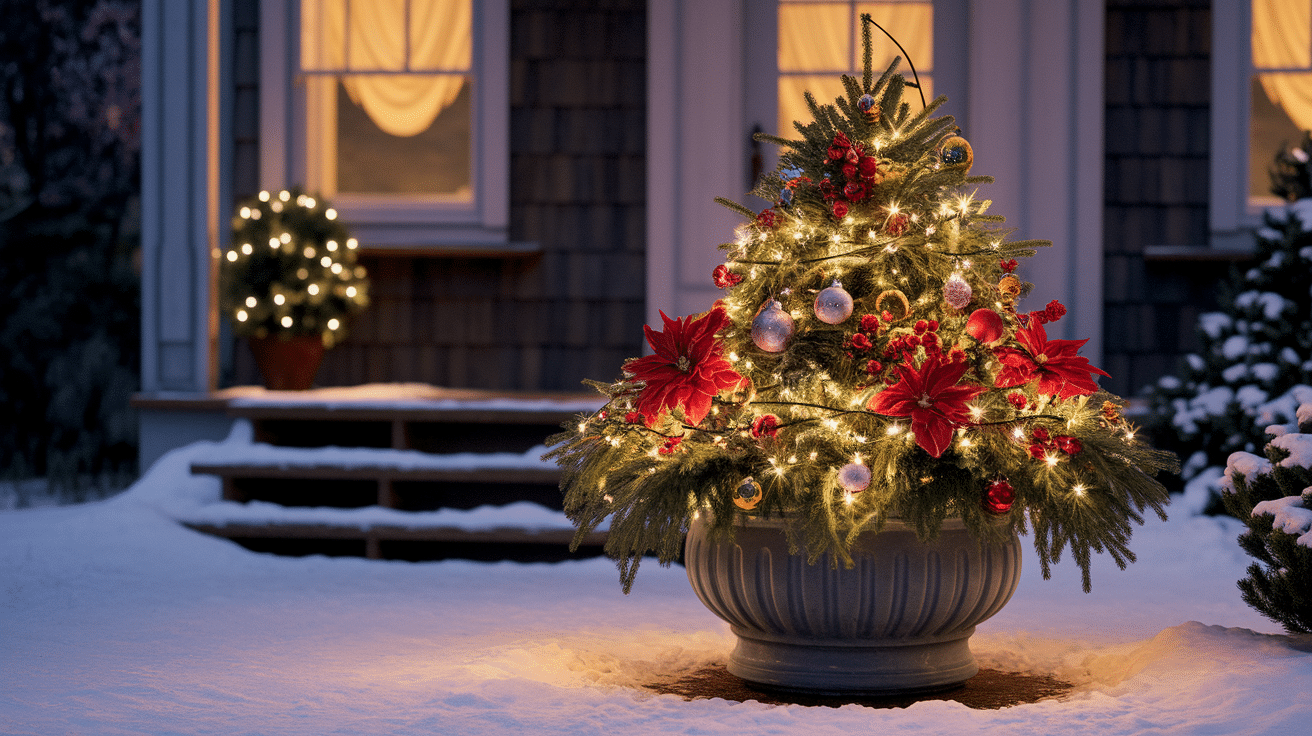
Holiday-themed planters are a way to bring the mood of each season into your garden or home.
For Halloween, Christmas, Easter, or any other holiday, you can adjust these planters to show the colors and symbols of the celebration.
These planters bring a cheerful feeling to your space and can help family or guests take part in decorating.
They also work well as table decorations for gatherings or as a welcome for visitors at your front door.
Pro Tip: You can easily switch out the plants to match the holiday.
27. Succulent Planters for Summer
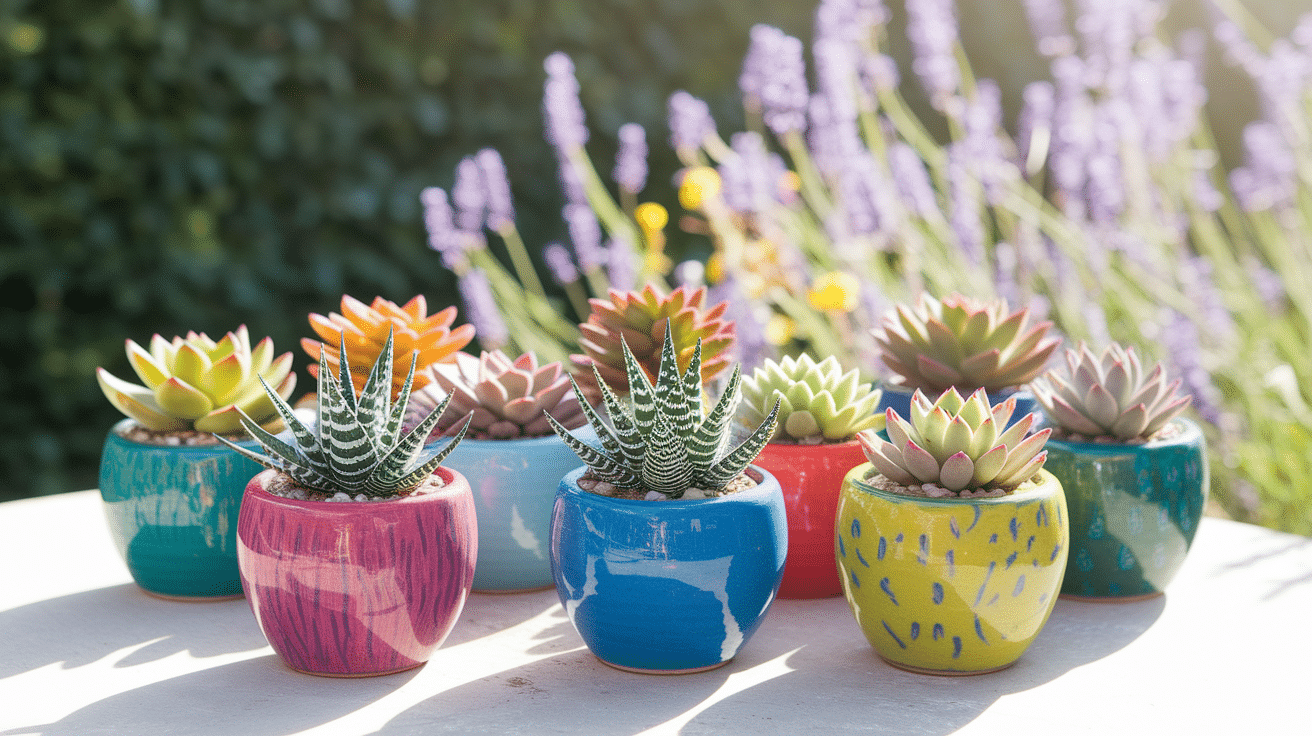
Succulent planters work well during the summer season, adding color and usefulness to your garden.
Succulents are drought-tolerant, low-maintenance, and come in a variety of colors, textures, and shapes.
These hardy plants thrive in hot, dry weather, making them ideal for summer gardening.
These strong plants grow well in heat and dry weather, so they suit summer gardening. You can place succulents in simple pots or containers with geometric shapes.
Pro Tip: To give your display a modern look, use smooth concrete or ceramic pots to highlight the plants’ natural colors.
28. Evergreen Planters for Winter
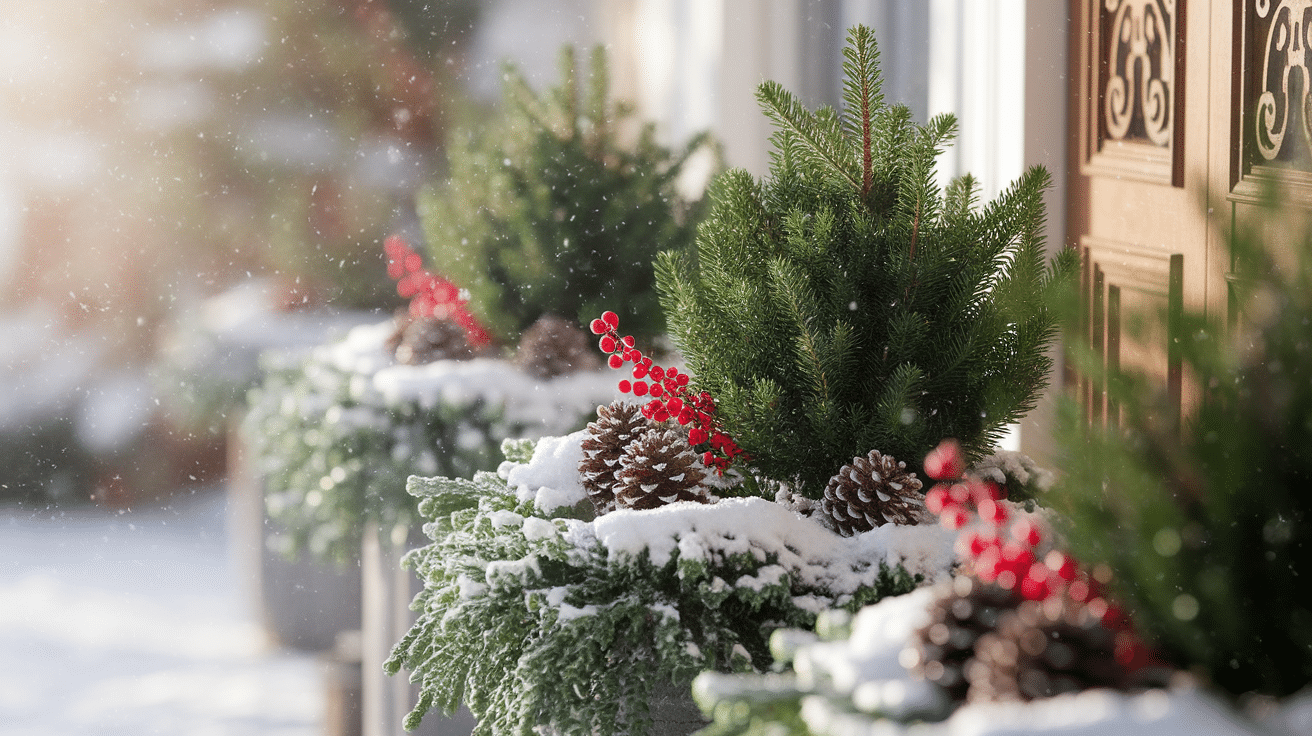
Evergreen planters are a good choice for winter, adding color, texture, and life to your outdoor space even in the cold months.
Plants like pine, fir, and spruce, as well as evergreen shrubs such as boxwood, provide a rich, green backdrop to the winter landscape.
These plants are hardy and keep their leaves all year, so you can rely on them to keep your garden looking green.
Pairing evergreens with winter-friendly decorations like pinecones, berries, or festive ribbons can boost the seasonal look.
Pro Tip: For a simple winter planter, fill a large pot with evergreen branches and add some red or gold ornaments to make it more festive.
29. Pumpkin Planters for Fall
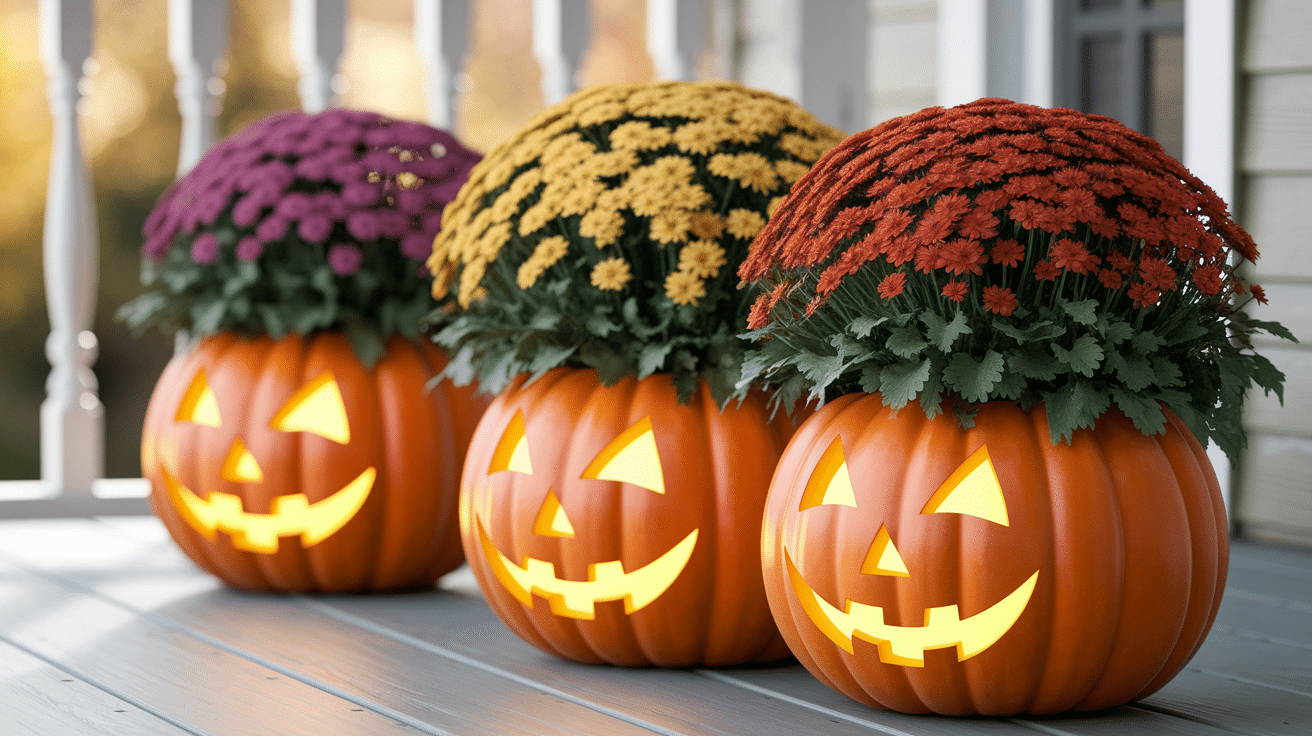
Pumpkin planters are a fun and festive way to celebrate the fall season.
Hollow out pumpkins and fill them with fall-themed plants such as mums, pansies, or ornamental kale to create an eye-catching display.
These planters are a great way to incorporate the seasonal harvest into your garden décor.
Their lively orange hues and rich textures make them a supreme choice for fall, and they pair beautifully with autumn colors like reds, browns, and golds.
Pro Tip: Once the pumpkin starts to decay, you can compost it or use it as mulch for other plants.
30. Miniature Planters
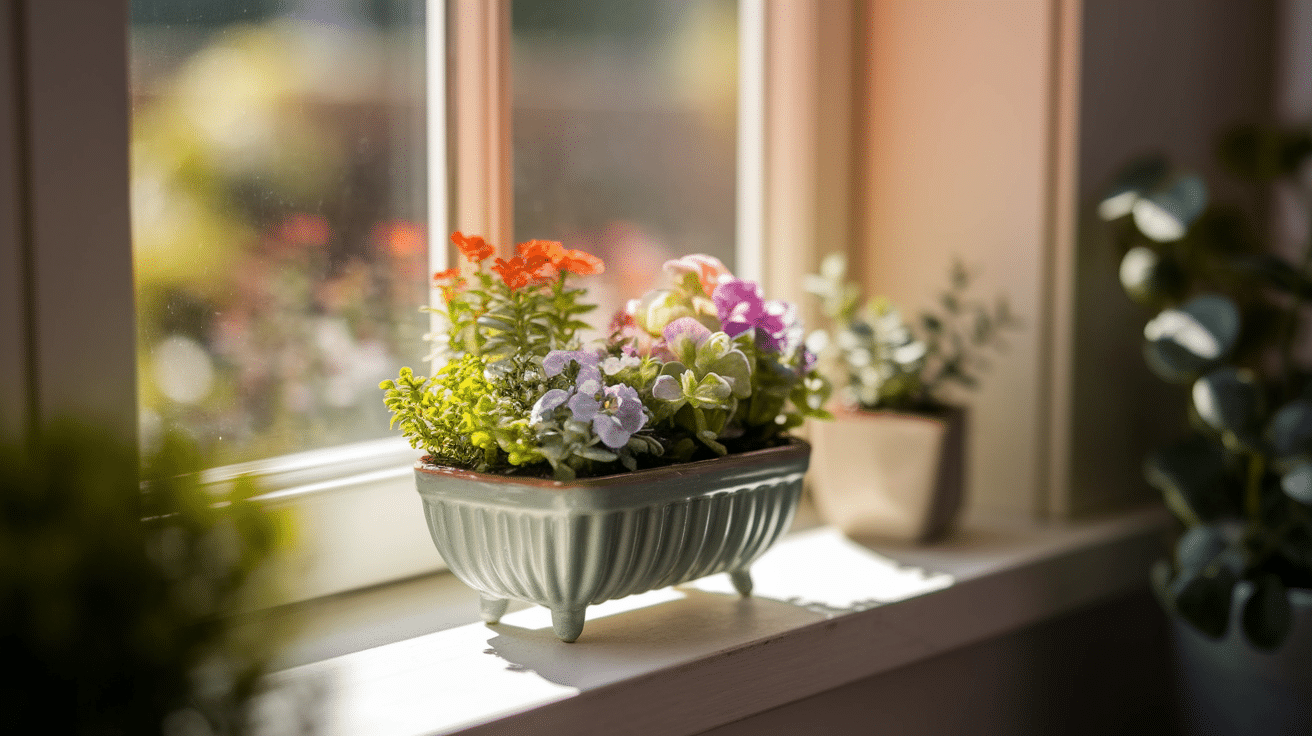
Miniature planters can be a good choice for balconies, windowsills, or small urban gardens where space is limited.
These small pots are useful for holding plants like succulents, herbs, or flowers, making them a good fit for areas where larger planters would take up too much room.
People often use these planters in groups to show off several plants together, or they space them apart to spread out bits of greenery along a railing or shelf.
Miniature planters help you fit in as many plants as you want and can add color and interest to your small garden.
Pro Tip: Group mini planters with different types of plants to create an appealing layered effect.
31. Hanging Herb Garden Planters
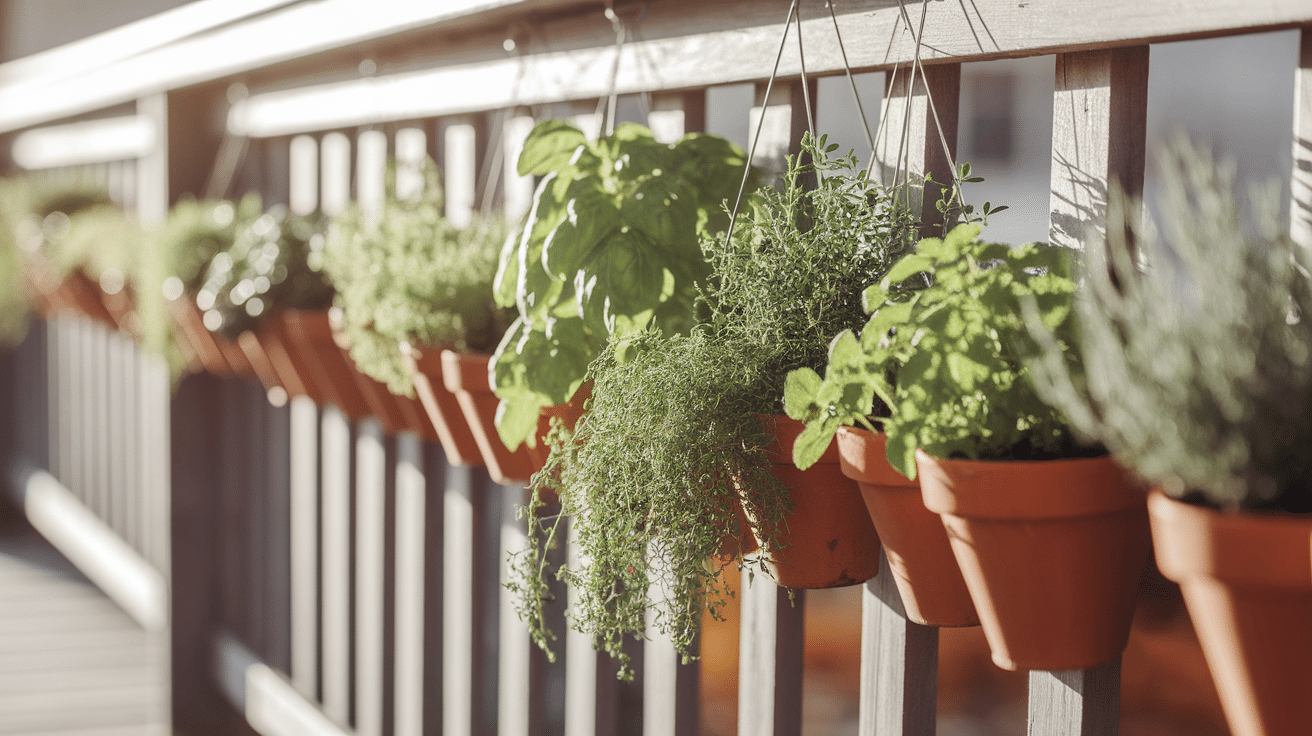
Hanging herb garden planters are a helpful solution for using vertical space and keeping fresh herbs within easy reach for cooking.
You can hang these planters from walls, ceilings, or railings, and many are arranged in rows or tiers to fit several plants.
These planters help save counter space and bring more greenery into your indoor or outdoor areas.
They work well for small kitchens or city gardens where there is not much extra space.
Pro Tip: Use lightweight containers for hanging herb garden planters to make installation easier.
32. Corner Shelf Planters
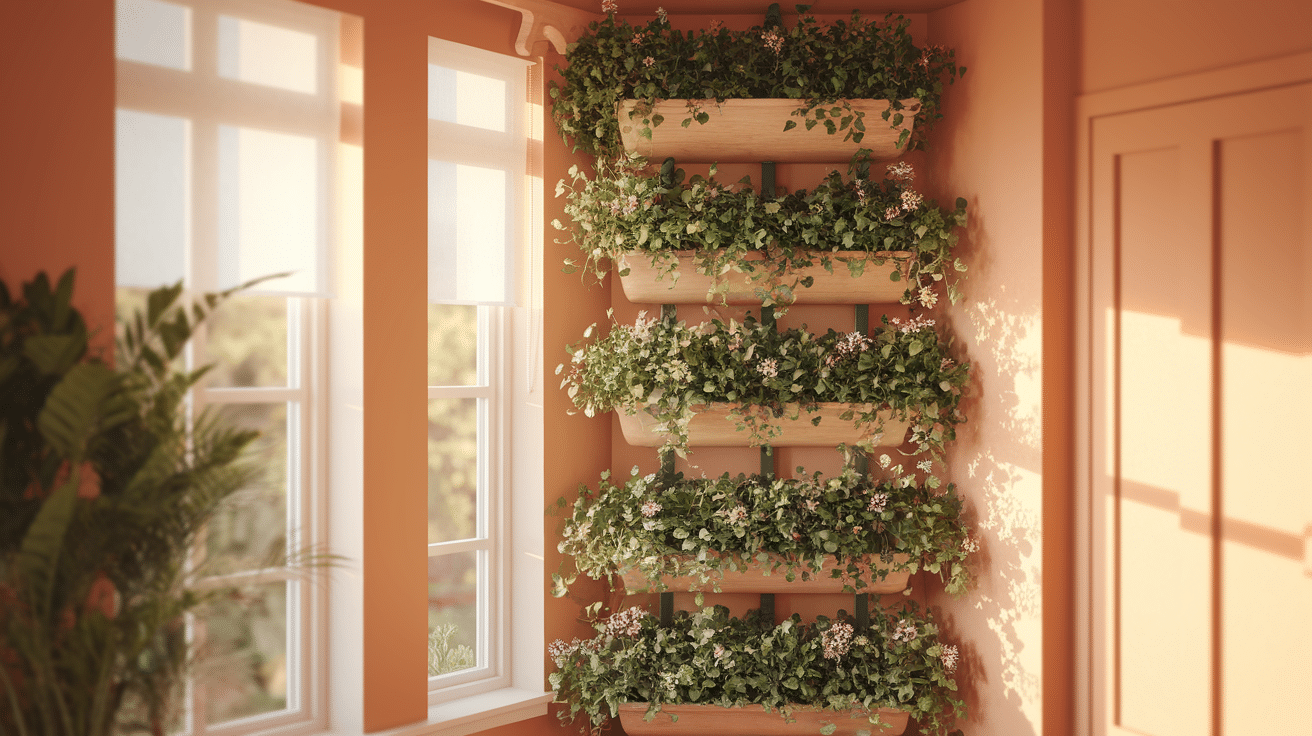
Corner shelf planters help you use space in the corners of your home or garden that might otherwise stay empty.
These tiered planters let you grow several plants one above the other, turning even a small spot into a space for greenery.
These planters work well for growing small plants such as succulents, flowers, or herbs.
Pro Tip: Arrange plants with different heights and leaves to add interest to your corner shelves.
33. Recycled Plastic Planters
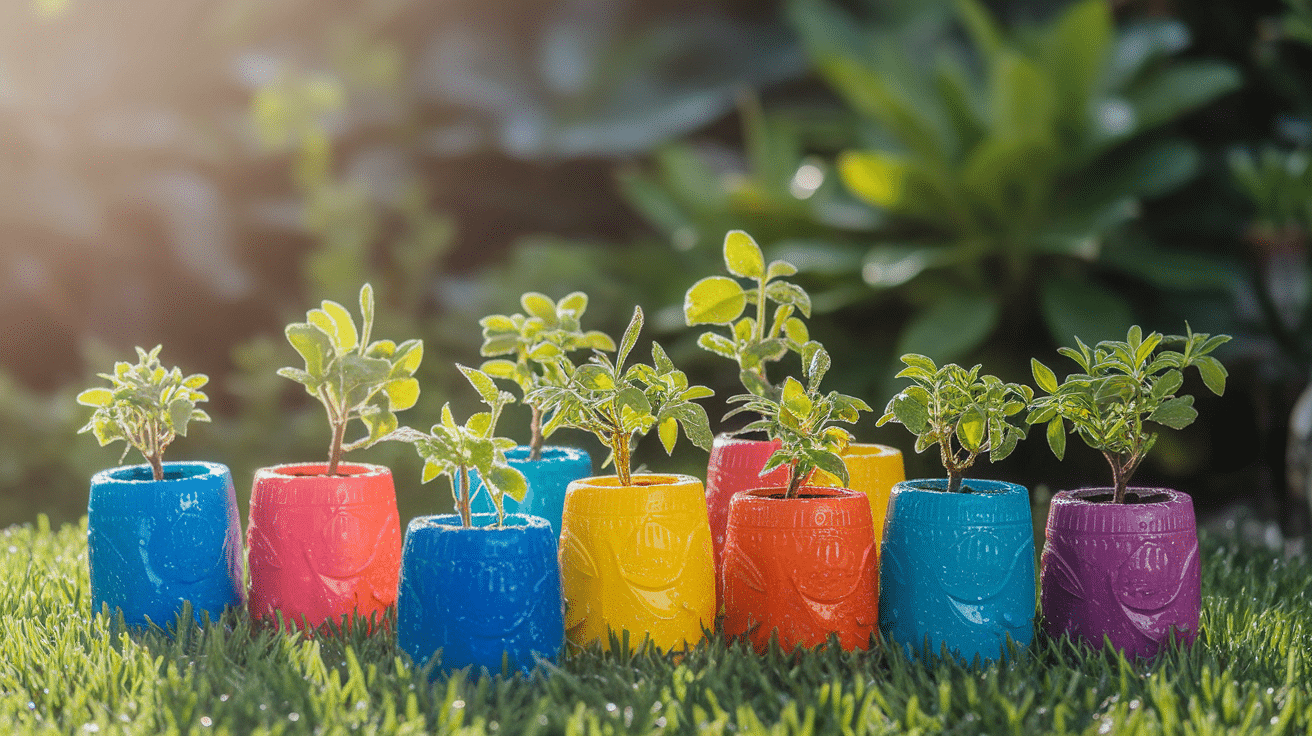
Recycled plastic planters are a useful way to reuse plastic waste and turn it into planters for your home or garden.
You can turn old plastic bottles, containers, and jars into planters with a few simple steps.
Just cut, paint, and decorate the plastic containers in a way that suits your space.
This method helps reduce plastic waste and lets you make planters that match your style.
Pro Tip: Use bright paints or simple patterns to add color to recycled plastic planters and help them stand out in your garden or home.
34. Biodegradable Pots
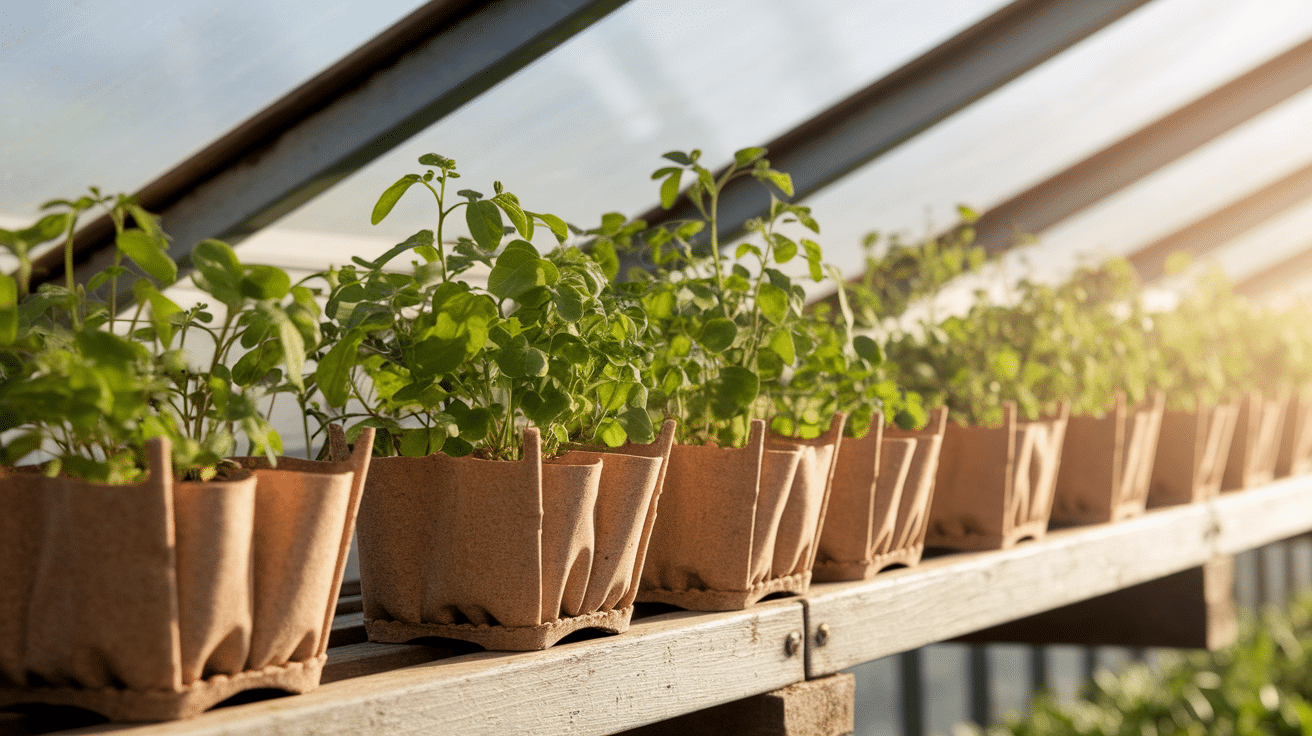
Biodegradable pots are a good, eco-friendly choice compared to regular plastic pots.
They are made from materials like coconut coir, peat, or recycled paper. These pots break down naturally, helping to cut down on waste.
Using these pots supports gardening with less impact on the environment.
Once they have served their purpose, you can add them to your compost or place them in the soil, as they will break down over time.
Pro Tip: When choosing biodegradable pots, look for ones made from natural materials like coconut coir. This can support a gardening routine that is gentle on the earth.
35. DIY Compostable Planters
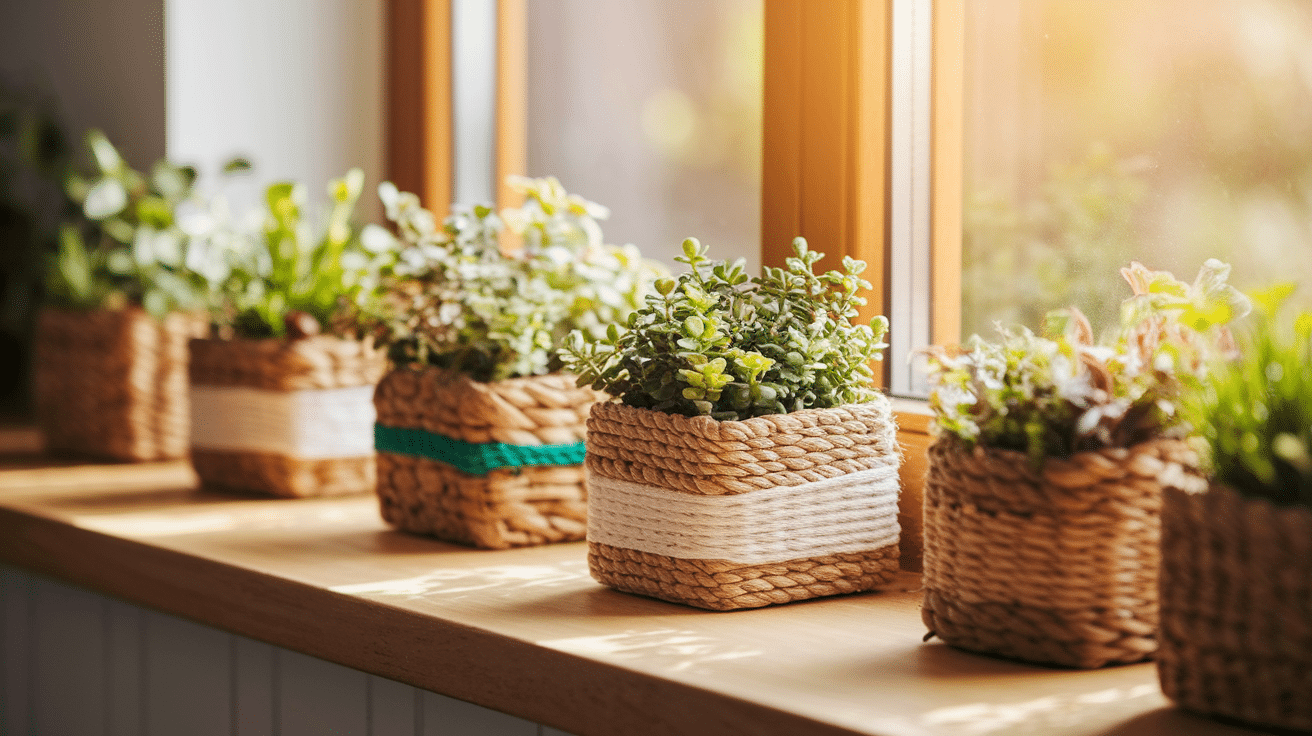
DIY compostable planters are a helpful way to make planters from natural materials that will break down over time.
You can use things like newspaper, cardboard, or straw to make your own compostable containers.
By shaping these materials into planters, you get a container for your plants that will add organic matter to the soil as it breaks down.
Pro Tip: Use a DIY compostable planter for short-term growing. When you notice the container starting to break down, plant the whole thing in the ground so the roots can keep growing without disruption.
Caring Tips for Flower Pots and Planter Ideas
To keep your flower pots and planters in top shape, here are some quick care tips:
- Proper Drainage: Ensure all pots have drainage holes to prevent root rot. Add gravel or rocks to improve drainage if necessary.
- Watering: Water regularly, but avoid over-watering. Check soil moisture and ensure thorough watering.
- Right Soil: Use a well-draining potting mix designed for containers, not garden soil.
- Fertilization: Feed your plants with slow-release or water-soluble fertilizers, following instructions to avoid over-fertilizing.
- Temperature Protection: Shield plants from extreme heat or frost, using shade or insulation when needed.
That’s a Wrap
Your home and garden deserve to look amazing, and the right pots and planters can make that happen without breaking the bank.
Once you start experimenting with different flower pot ideas, you’ll see how easy it is to refresh your space whenever you want a change.
Take good care of your planters, choose plants that make you happy, and watch how these simple additions bring new life to your surroundings.
Your outdoor and indoor spaces are about to become your favorite places to relax and enjoy!

